12 Star Trek Gadgets That Now Exist
By john brandon | oct 29, 2015.

For geeks growing up in the 1960s, '80s and '90s, a vision of the future has been provided by one very successful television franchise: Star Trek. And the future, it turns out, is coming sooner than even Trek 's writers could have imagined. Here are 12 gizmos used on the Star Trek television shows that are now becoming real.

1. Food Replicator
Captain Jean-Luc Picard used to say "Tea, Earl Grey, hot!" and it would be replicated instantly. Today's 3D printers don't tackle tea, but there are machines that actually can print food. And other printers, like the MakerBot Replicator 2 are quite adept at making small objects—just as they were shown to do on later episodes of Star Trek: The Next Generation .
2. Universal Translator
In several episodes, we marveled at the universal translator, which decoded what aliens said in real-time—and in the later shows, it was integrated into the communication badges (which explains why basically everyone, regardless of home planet, spoke English). Now, there's an app for that. Voice Translator by TalirApps understands 71 languages (no Klingon yet, though). You speak in your native tongue and the app translates your phrase into another language.
3. Tablet Computers
Lieutenant Commander Geordi La Forge—you know, the guy from Reading Rainbow —used a tablet computer (what they called Personal Access Data Devices, or PADDs) to punch in coordinates for the next star system. Other Starfleet personnel used them to watch videos and listen to music—just the things we use tablets for today.
4. Tricorder
In the TV show, a tricorder is a handheld device that scans for geological, biological, and meteorological anomalies. Handy! In 2012, Peter Jansen from McMaster University in Ontario built a working prototype that scans for magnetic fields and other interference. And there are lots of other real-world tricorders , too.
5. Holodeck
On Star Trek: The Next Generation , you could walk into a chamber on the Enterprise and visit your home planet for a quick barbecue, or even have an affair with a hologram . Leave it to a bunch of University of Southern California students to make virtual reality a little more down-to-Earth— Project Holodeck used virtual reality goggles to create a fictional world. (Though no encounters with Minuet were reported.)
6. Communicator Badge
On the original series, Kirk and crew carried handheld communicators . But in Star Trek: The Next Generation , Starfleet personnel wore communicator badges on the left breasts of their uniforms. A California start-up called Vocera has created a similar device you pin to your shirt. They're used mostly in hospitals to avoid having constant overhead pages.
7. Tractor Beam
Pulling a ship with an invisible tractor beam seems impossible, but two New York University professors are making it so . Their experiment, which uses a light beam to control tiny microscopic particles, is not going to be deployed on the next NASA mission, but shows we’re making progress.
8. Natural Language Queries
In the Star Trek universe, you can talk to a computer (voiced by Majel Barrett-Roddenberry, Trek creator Gene's wife) in casual conversation. These days, we've got Siri and Alexa, and while they aren't fully developed systems yet, they are baby steps toward a service like Star Trek 's computer, which has a complex understanding of context. Google even codenamed their voice-based service "Majel," in honor of Barrett-Roddenberry.
9. Warp Drive
No one in Star Trek ever sits down and explains how a warp drive works in detail, but we know it has something to do with bending space and traveling faster than the speed of light. Doesn’t seem possible, but NASA is working on it.
Captain Kirk was pretty handy with a phaser, and he didn’t always set his to stun. Ironically, we’ve been using something similar since the first Iraq War. Known as a dazzler, the directed-energy weapon sends a pulse of electromagnetic radiation to stop someone cold in their tracks.
11. Teleportation
To get from place to place, Captain Kirk and company didn't need an airplane—they didn't even need a space elevator. Instead, they teleported using the U.S.S. Enterprise 's transporter (a scenario we all dream about while standing in line at airport security). We've already done some teleportation—specifically, of photons and atoms . These particles don't disappear and reappear, though. According to Forbes, "the information contained in the photon’s quantum state is transmitted from one photon to another through quantum entanglement – without actually travelling the intervening distance." An exact copy appears on the other side, while the original photon is destroyed. According to theoretical physicist Michio Kaku, we consist of 15 trillion cells, so we'll need to wait a few centuries before we're teleporting like Kirk. And we'll still have to destroy the original.
12. Hypospray
In the world of Star Trek , there's no need for needles (and thus no trypanophobia )—Bones administered medicine through the skin using painless jet-injected hypospray. Recently, MIT created a similar device that, according to Geek.com , "delivers a drug through the skin at speeds of up to 340 meters per second and in under a millisecond. The amount of drug can be varied, as can how deep it is injected. And as far as the patient is concerned, they shouldn’t feel anything other than the tip of the injector against their skin. That’s because the jet is as thin as a mosquito’s proboscis." It's not the first, but it does have more control than other hyposprays, which means it could actually be a replacement for needles—and that would make visits to the doctor's office with your kids much easier.
Advertisement
10 'Star Trek' Technologies That Actually Came True
- Share Content on Facebook
- Share Content on LinkedIn
- Share Content on Flipboard
- Share Content on Reddit
- Share Content via Email
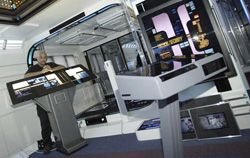
"Beam us up." It's one of the most iconic lines in television history. It's something often heard in the hit science fiction television series "Star Trek" and all of the television shows and movies that followed.
The transporter essentially dematerialized a human body at one point only to rematerialize it in the transporter bay on the ship. Somehow, it broke down atoms and molecules within the body -- scattered them through the vacuum of space without losing a single one from point A to point B, then voila, that person re-emerged out of thin air. Sounds pretty cool, though impossible, right? But what if there was such a device?
The truth is, you can forget about a transporter. No one has been able to realize such a concept. But that doesn't mean some of the ideas that seemed far-fetched when the show debuted in 1966 haven't become a reality. In this article, we feature the top 10 technologies from Star Trek that actually did come to fruition, listed in no particular order. Some of them may surprise you.
- Transparent Aluminum (Armor)
- Communicators
- Tractor Beams
- Universal Translator
- Geordi's VISOR
- Torpedo Coffins
- Telepresence
10: Transparent Aluminum (Armor)
The fourth installment of the original "Star Trek" movies is perhaps the most endearing to fans. The crew returns to modern-day Earth. Kirk, Spock and the rest of the gang ditch a Klingon Bird of Prey spacecraft in the San Francisco Bay after narrowly missing the Golden Gate Bridge while flying blind in a storm. You may remember the scene -- but how many of you remember Scotty introducing transparent aluminum for the first time?
In the flick, Scotty traded the formula matrix for transparent aluminum -- a huge engineering advancement -- for sheets of plexiglass in order to build a tank to transport the two humpback whales (George and Gracie) to the Earth of their time. The claim was that you'd be able to replace six-inch (14-centimeter) thick Plexiglas with one-inch (2.5-centimeter) thick see-through aluminum.
It may sound impossible, but there is such a thing as transparent aluminum armor or aluminum oxynitride (ALON) as it's more commonly known. ALON is a ceramic material that starts out as a powder before heat and pressure turn it into a crystalline form similar to glass. Once in the crystalline form, the material is strong enough to withstand bullets. Polishing the molded ALON strengthens the material even more. The Air Force has tested the material in hopes of replacing windows and canopies in its aircraft. Transparent aluminum armor is lighter and stronger than bulletproof glass . Less weight, stronger material -- what's not to like?
9: Communicators

Whenever Captain Kirk left the safe confines of the Enterprise, he did so knowing it could be the last time he saw his ship. Danger was never far away. And when in distress and in need of help in a pinch, he could always count on Bones to come up with a miracle cure, Scotty to beam him up or Spock to give him some vital scientific information. He'd just whip out his communicator and place a call.
Fast-forward 30 years and wouldn't you know it, it seems like everyone carries a communicator. We just know them as cell phones . Actually, the communicators in "Star Trek" were more like the push-to-talk, person-to-person devices first made popular by Nextel in the mid to late '90s. The "Star Trek" communicator had a flip antenna that when opened, activated the device. The original flip cell phones are perhaps distant cousins. Whatever the case, the creators of "Star Trek" were on to something because you'd be hard-pressed to find many people without a cell phone these days.
In later incarnations of the "Star Trek" franchise, the communicators evolved to being housed in the Starfleet logo on the crewman's chest. With the tap of a finger, communication between crewmembers became even easier. Vocera Communications has a similar product that can link people on the same network inside a designated area like an office or a building by using the included software over a wireless LAN. The B2000 communication badge weighs less than two ounces and can be worn on the lapel of a coat or shirt and allows clear two-way communication. It's even designed to inhibit the growth of bacteria so it's suitable for doctors [source: Vocera ].
8: Hypospray
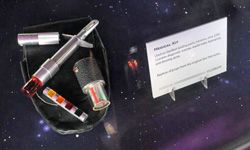
The creative team behind "Star Trek" found spiffy ways to spice up some activities we endure on a day-to-day basis. Take medical treatment, for example: Not many people enjoy getting a flu shot, and in "Star Trek," inoculating patients was one of Dr. Leonard "Bones" McCoy's primary duties. It seemed not an episode went by that Bones wasn't giving someone a shot of some sort of space vaccine . But what was more fascinating was the contraption he used.
Hypospray is a form of hypodermic injection of medication. A hypospray injection is forced under the skin (a subcutaneous injection) with high air pressure. The air pressure shoots the liquid vaccine deep enough into the skin that no needle is required. The real-world application is known as a jet injector .
Jet injectors have been in use for many years. In fact, the technology predates "Star Trek." Jet injectors were originally designed to be used in mass vaccinations. Jet injecting is safer (no needles to pass along infectious disease) and faster in administering vaccines. Similar in appearance to an automotive paint gun, jet injection systems can use a larger container for the vaccine, thus allowing medical personnel to inoculate more people quicker.
7: Tractor Beams
When NASA needs to make repairs to the Hubble Space Telescope, astronauts have to be specially trained to get out of the Space Shuttle for extravehicular activity. They also have to learn how to work within the confines of their space suits, with thick gloves on. Wouldn't it be nice to just bring the telescope inside, where repairs wouldn't be so challenging and dangerous?
In science fiction, space ships including the Starship Enterprise snatch each other up using tractor beams. In some cases, large vessels have a tractor beam strong enough to prevent smaller vessels from escaping the gravitational force. So is this science even plausible?
Yes and no. Optical tweezers are as close as you're going to get to a legitimate tractor beam on current-day Earth. Scientists have harnessed small lasers into beams capable of manipulating molecules and moving them with precision. Optical tweezers use a focused laser to trap and suspend microscopic particles in an optical trap. Scientists can use optical tweezers to trap and remove bacteria and sort cells. Optical tweezers are used primarily in studying the physical properties of DNA. While the beams used in optical tweezers aren't strong enough to dock the space shuttle to the International Space Station, it's a start in that direction.
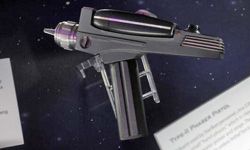
"Set phasers to stun" -- another oft-heard command given to the Enterprise crew. The crew often relied on the stun setting of their fictitious weapon of choice known as a phaser. Armed with a phaser, Kirk and his colleagues had the ability to kill or more desirably, stun their adversaries and render them incapacitated.
Actually, stun guns have been around for some time. In fact, electricity has been used for punishment and to control livestock as far back as the 1880s. But it wasn't until 1969 when a guy named Jack Cover invented the first Taser that the stun gun was most realized. The Taser fails to kill like the phaser did, yet, it packs enough of an electrical punch to render its victim disorientated, if not completely incapacitated.
Unlike the phaser, the Taser and other stun guns must come in physical contact with the target in order to have any effect. Tasers take care of this by projecting two electrodes, connected by wires, which attach to the target's skin. Once in contact, the handheld unit transfers electricity to the target, thus having the stun effect. Stun guns with stationary electrical contact probes are somewhat less effective because while they have a similar effect on the target, you have to be much closer (within arm's length) in order to zap your target.
Something more along the lines of the phaser may be in development. Applied Energetic has developed Laser Guided Energy and Laser Induced Plasma Energy technologies that are said to transmit high-voltage bursts of energy to a target [source: Applied Energetics ]. In other words, these pulses of energy would stun the target and limit collateral damage. So a true phaser may soon be a reality.
5: Universal Translator
Imagine if no matter what country you visited, no matter what the culture, you could understand everything the indigenous people were saying. It sure would make traveling easier. Take that thought to another level like say, if you were planet hopping like the crew onboard the Enterprise. Fortunately for Captain Kirk and his peers, they had a universal translator .
The characters in "Star Trek" relied on a small device that when spoken into, would translate the words into English. Guess what? The technology exists for us in the real world. There are devices that let you speak phrases in English and it will spit back to you the same rhetoric in a specified language. The only problem is, these devices only work for certain predetermined languages.
A true universal translator like the one on the show may not be a reality, but the technology is available. Voice recognition has advanced considerably since its inception. But computers have yet to be able to learn languages. Computers would be able to theoretically gather the information much faster than a human brain, but a software program is dependent on actual data. Someone has to take the time and expense to put it together and make it available, which is probably why these systems focus on more popular languages.
4: Geordi's VISOR
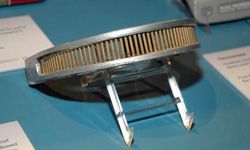
When "Star Trek: The Next Generation" thrust the love of everything "Star Trek" back into popular culture, the quirky Mr. Spock and crass Bones McCoy and others were supplanted by a new cast. One of the most popular characters on the new show was engineer Geordi LaForge.
What made Geordi unique, perhaps even mysterious, was his funky eyewear. Geordi was blind, but after a surgical operation and aided through the use of a device called VISOR (Visual Instrument and Sensory Organ Replacement), Geordi could see throughout the electromagnetic spectrum. Though it may sound far-fetched, in reality, similar technology exists that may someday bring sight back to the blind.
In 2005, a team of scientists from Stanford University successfully implanted a small chip behind the retina of blind rats that enabled them to pass a vision recognition test. The science behind the implants, or bionic eyes as they're commonly referred to, works much the way Geordi's VISOR did. The patient receives the implants behind the retina, then wears a pair of glasses fitted with a video camera. Light enters the camera and is processed through a small wireless computer, which then broadcasts it as infrared LED images on the inside of the glasses. Those images are reflected back into the retina chips to stimulate photodiodes. The photodiodes replicate the lost retinal cells then change light into electrical signals which in turn send nerve pulses to the brain.
What it all means is that in theory, a person with 20/400 sight (blind), due to the loss of retinal cells from retinitis pigmentosa, can obtain 20/80 sight. It's not good enough to pass the driving test (normal vision is considered 20/20) but it's good enough to read billboards and go about your day without the aid of a seeing-eye dog.
3: Torpedo Coffins
In the second installment of the "Star Trek" movie franchise, the beloved Mr. Spock, played by Leonard Nimoy, died after saving the Starship Enterprise from certain disaster. The movie culminated with the crew firing Spock's corpse out of the torpedo bay in a coffin shaped like one of the ship's weapons, the photon torpedo .
Believe it or not, you too could be laid to eternal rest in your own Federation-approved photon torpedo casket. OK, it may not technically be Federation-approved since there is no such thing as the United Federation of Planets (UFP) but the coffins are, in fact, very real.
Designed by Eternal Image, the "Star Trek" coffin was slated to be available early 2009, but is still not for sale as of this writing. The price is yet to be determined. If the fan would prefer to be cremated , the company also plans to offer a "Star Trek" urn as well.
2: Telepresence
In 1966, the idea of interacting with each other while separated by the void of space seemed as far fetched as, well the idea of being in space. That's precisely what the idea of telepresence is.
Telepresence is more than just video conferencing . The visual aspect is important and immersion is vital. In other words, the more convincing the illusion of telepresence, the more you feel like you're there.
In 2008, AT&T teamed up with Cisco in delivering the industry's first in-depth telepresence experience. The key to Cisco's TelePresence is the combination of audio, video and ambient lighting working together. These telepresence kits are designed to mirror surroundings and mimic sounds so that users on each side of the video conference will feel as though the images on the screen are in the same room with them. For instance, the people in boardroom A will see the people on the screen in boardroom B as though they are sitting across the table from them. The ambient lighting and room features are constructed to mirror each other. Sure, these telepresence kits are much more advanced than anything drummed up on "Star Trek," but perhaps that's because the show sparked our imagination so many years ago.
1: Tricorders
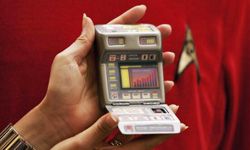
How many of you remember that instrument Mr. Spock used to always carry over his shoulder, especially when the crew (usually consisting of only Spock and Captain Kirk) first surveyed a new planet? That was a tricorder.
One of the more useful instruments available to "Star Trek" personnel, variations of the tricorder (medical, engineering or scientific) were used to measure everything from oxygen levels to detecting diseases. Often times the tricorder gave an initial analysis of the new environment. So, what's the real-world tie-in? NASA employs a handheld device called LOCAD, which measures for unwanted microorganisms such as E. coli, fungi and salmonella onboard the International Space Station [source: Coulter ]. Beyond that, two handheld medical devices may soon help doctors examine blood flow and check for cancer, diabetes or bacterial infection.
Scientists at Loughborough University in England use photoplethysmography technology in a handheld device that can monitor the functions of the heart. Meanwhile, researchers at Harvard Medical School have developed a small device that utilizes similar technology found in MRI machines that non-invasively inspect the body. Using nuclear magnetic resonance imaging, this device would be sensitive enough to measure samples of as few as 10 possible infectious bacteria. This kind of sensitivity (800 times more sensitive than sensing equipment currently used in medical labs) could revolutionize the way doctors diagnose disease [source: Mick ].
Lots More Information
Related howstuffworks articles.
- 10 Essential Gadgets
- 10 Long-running TV Shows
- Who Said It: Captain Kirk or Picard?
- How Stun Guns Work
- How Military Pain Beams Will Work
- How Transparent Aluminum Armor Works
- How Does "Bulletproof" Glass Work?
- What makes glass transparent?
- How Military Snipers Work
- How Body Armor Works
- How Liquid Body Armor Works
- How Warp Speed Works
- How Antimatter Spacecraft Will Work
- How Rocket Engines Work
- How Sci-Fi Doesn't Work
- Do parallel universes really exist?
- How Time Travel Will Work
- How Teleportation Will Work
More Great Links
- "Star Trek" Official Home Page
- U.S. Air Force
- Applied Energetics. "Laser Guided Energy." (Nov. 9, 2009) http://ionatron.net/laser-guided-energy.asp
- AT&T. "AT&T first service provider to deliver intercompany Cisco telepresence for business around the world." April 21, 2009. (Oct. 21, 2009) http://www.att.com/gen/press-room?pid=4800&cdvn=news&newsarticleid=25523
- Bartkewicz, Anthony. "Company creates Star Trek coffins." KRQE.com. April 6, 2009. (Oct. 21, 2009) http://www.krqe.com/dpp/news/strange/offbeat_dpgo_Company_creates_Star_Trek_coffins_SAB_040420092296082
- Batchelor, David Allen. "The Science of Star Trek." NASA. (Oct. 22, 2009) http://ssdoo.gsfc.nasa.gov/education/just_for_fun/startrek.html#transporter
- BBC News. "'Star Trek device' could detect illness." Sept. 20, 2002. (Oct. 20, 2009) http://news.bbc.co.uk/2/hi/health/2231989.stm
- Cisco. "Telepresence: Product information." (Oct. 21, 2009) http://www.cisco.com/en/US/products/ps7060/index.html#,hide-id-trigger-g1-room_environments
- Coulter, Dauna. "Space Station Tricorder." Science@NASA. May 9, 2008. (Nov. 6, 2009) http://science.nasa.gov/headlines/y2008/09may_tricorder.htm?list185546
- Cruz, Gilbert. "Jack Cover." Time Magazine. Feb. 19, 2009. (Oct. 19, 2009) http://www.time.com/time/magazine/article/0,9171,1880636,00.html
- Lundin, Laura. "Air Force testing new transparent armor." U.S. Air Force. Oct. 17, 2005. (Oct. 21, 2009) http://www.af.mil/news/story.asp?id=123012131
- Mick, Jason. "New "miracle diagnosis" handheld medical scanner 800 times more sensitive than full-size scanners." Daily Tech. July 10, 2008. (Oct. 21, 2009) http://www.dailytech.com/article.aspx?newsid=12322
- National Institute of Standards and Technology. "Optical Tweezers." (Oct. 20, 2009) http://physics.nist.gov/Divisions/Div842/Gp4/Tweezers/research.html#polymerosomes
- Schirber, Michael. "Doctors could go needle-free, but sticking points remain." Live Science. Oct. 4, 2006. (Oct. 21, 2009) http://www.livescience.com/health/061004_needle_free.html
- Stanford.edu."Optical tweezers; an introduction." (Oct 22, 2009) http://www.stanford.edu/group/blocklab/Optical%20Tweezers%20Introduction.htm
- Star Trek.com. (Oct. 20, 2009) http://www.startrek.com/startrek/view/library/characters/TNG/bio/1112463.html
- Vocera. (Oct. 22, 2009) http://www.vocera.com/products/products.aspx
- Young, Kelly. "'Bionic eye' may help reverse blindness." New Scientist. March 31, 2005. (Oct. 22, 2009) http://www.newscientist.com/article/dn7216
Please copy/paste the following text to properly cite this HowStuffWorks.com article:
- What is ChatGPT?
- How to Use Google Gemini
- Emerging Tech
Make it so! 8 ‘Star Trek’ technologies that actually exist now (sort of)
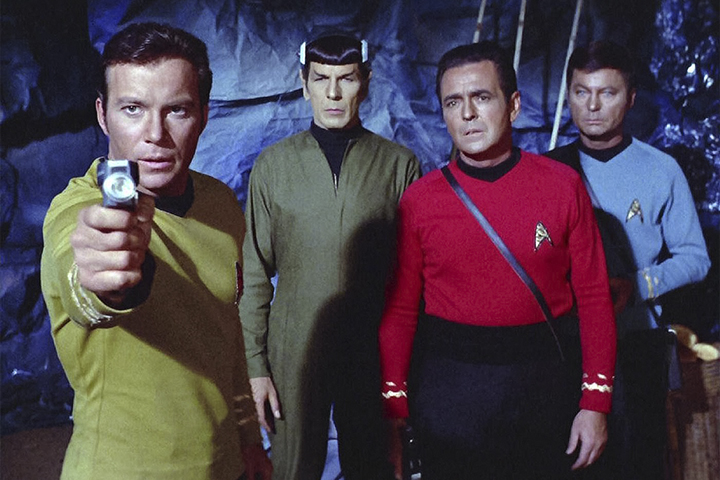
For the past half-century, across hundreds of TV episodes, multiple spinoffs, and more than a dozen movies, Star Trek has offered us a tantalizing glimpse of the future. Along the way, that’s included plenty of amazing technologies that have the potential to reshape life as we know it.
Tractor beams
Universal translators, computers we can speak to, tablet computer, food replicator.
While much of it remains science fiction, a sizable number of the gadgets and tech toys that have appeared in Star Trek now exist, to some degree, in today’s world. Here are eight great examples.
Star Trek ’s tractor beam is an attenuated linear graviton beam which can be used by space stations or starships to control the movement of external objects — such as towing disabled ships to safety.
Researchers from the U.K.’s University of Bristol have developed and successfully demonstrated an acoustic tractor beam capable of trapping small objects in midair. In the near future, they hope tractor beams will be useful for moving things like kidney stones or eye floaters in the human body. Okay, so that’s not quite the same as trapping a Klingon starship, but it’s a good start!
We’re way ahead of the curve on this one! Star Trek claims that the universal translator, a device able to instantaneously translate between different languages, only comes into being late in the 22nd century.
Here in the 21st century, there are devices like Baidu’s pocket universal translator that’s able to easily translate spoken sentences from English into Mandarin and back again. Google has also developed in-ear translation earbuds for translating between numerous languages, and there are even apps capable of translating a baby’s cries into English .
Right now, the big difference between Star Trek ’s technology and ours is the amount of time it takes to train these devices to understand new languages.
Phased array pulsed energy projectiles, Star Trek ’s phasers come in various different sizes, ranging from personal small arms to giant energy weapons capable of being mounted onto starships. They can also be used in a variety of ways, such as slicing through materials, heating objects, triggering explosions, or simply stunning an adversary.
In the current world, we’re still stuck using the phaser’s antecedent, the humble laser. On the plus side, laser projectiles are becoming more commonplace — including handheld laser cannons and Lockheed Martin’s modular ATHENA laser weapon , designed to shoot swarms of drones out of the sky.
Allowing the crew in Star Trek to interact with computers by speaking to them solves one of the big screenwriting problems: making computer interactions both clear to the audience and interesting in a way that having everyone typing on keyboards simply wouldn’t be. Plus, nothing says “far future” quite like having your computer understand verbal commands, right?
Here in 2018, this is now so commonplace that we considered not even including it on this list. Almost all of our smartphones have A.I. assistants such as Apple’s Siri, while one of the fastest growing product categories is smart speakers like the Amazon Echo .
If you really, really hate needles then the existence of the “hypospray” would be enough to make Star Trek ’s vision of the future sound like a utopia. Known colloquially as a “hypo,” this injection-free drug delivery system can inject liquids into the body at high speed without having to puncture the skin.
Today, an MIT spinoff called Portal is working on a next-generation needle-free jet injector , capable of injecting an ultra-fine stream of liquid — thinner than a strand of hair — through the skin at Mach 0.7. For those keeping track at home, that’s the cruising speed of an average commercial airliner. While it still involves piercing the skin, it’s a world away from the syringes in wide use today.
Like computers which recognize your voice, this is one that always seems too obvious to mention nowadays. Nonetheless, within many of our lifetimes (certainly if you’re in your late twenties or older), we’ve watched computers slim down from bulky machines into flat, all-in-one devices no thicker than a pencil.
A person watching Star Trek: The Next Generation today may not realize how futuristic something like the crew’s Personal Access Data Devices (PADD) once appeared. But, trust us, it really was!
Unless you’re someone who simply loves the act of cooking, the idea of a Star Trek -style replicator, capable of materializing food and beverages sounds like a dream come true. Thanks to the wonders of modern science, it may not remain a dream for too much longer.
Food-based 3D printing is starting to hit its stride , while the National University of Singapore has developed a programmable cocktail glass , capable of tricking your senses into thinking that you’re drinking … well, just about anything you can imagine, really.
Aside from teleportation (which sadly isn’t a real thing just yet), warp speed is the most iconic Star Trek technology out there. It’s also the furthest away of any on this list — although it’s not impossible that we’ll get there.
In recent years, excitement has been building about NASA’s EmDrive technology , which could lead to ultrafast interplanetary travel. It’s not a “warp drive” per se, but should a real world demonstration actually happen, it’ll likely change our understanding of physics as we currently know it. But it’s also no longer a total fantasy, either.
- Entertainment
- Artificial Intelligence

CES is more than just a neon-drenched show-and-tell session for the world’s biggest tech manufacturers. More and more, it’s also a place where companies showcase innovations that could truly make the world a better place — and at CES 2023, this type of tech was on full display. We saw everything from accessibility-minded PS5 controllers to pedal-powered smart desks. But of all the amazing innovations on display this year, these three impressed us the most:
Samsung's Relumino Mode Across the globe, roughly 300 million people suffer from moderate to severe vision loss, and generally speaking, most TVs don’t take that into account. So in an effort to make television more accessible and enjoyable for those millions of people suffering from impaired vision, Samsung is adding a new picture mode to many of its new TVs. [CES 2023] Relumino Mode: Innovation for every need | Samsung Relumino Mode, as it’s called, works by adding a bunch of different visual filters to the picture simultaneously. Outlines of people and objects on screen are highlighted, the contrast and brightness of the overall picture are cranked up, and extra sharpness is applied to everything. The resulting video would likely look strange to people with normal vision, but for folks with low vision, it should look clearer and closer to "normal" than it otherwise would. Excitingly, since Relumino Mode is ultimately just a clever software trick, this technology could theoretically be pushed out via a software update and installed on millions of existing Samsung TVs -- not just new and recently purchased ones.
These days, it seems like there's nothing AI programs can't do. Thanks to advancements in artificial intelligence, deepfakes have done digital "face-offs" with Hollywood celebrities in films and TV shows, VFX artists can de-age actors almost instantly, and ChatGPT has learned how to write big-budget screenplays in the blink of an eye. Pretty soon, AI will probably decide who wins at the Oscars.
Within the past year, AI has also been used to generate beautiful works of art in seconds, creating a viral new trend and causing a boon for fan artists everywhere. TikTok user @cyborgism recently broke the internet by posting a clip featuring many AI-generated pictures of Breaking Bad. The theme here is that the characters are depicted as anime characters straight out of the 1980s, and the result is concerning to say the least. Depending on your viewpoint, Breaking Bad AI (my unofficial name for it) shows how technology can either threaten the integrity of original works of art or nurture artistic expression. What if AI created Breaking Bad as a 1980s anime? Playing over Metro Boomin's rap remix of the famous "I am the one who knocks" monologue, the video features images of the cast that range from shockingly realistic to full-on exaggerated. The clip currently has over 65,000 likes on TikTok alone, and many other users have shared their thoughts on the art. One user wrote, "Regardless of the repercussions on the entertainment industry, I can't wait for AI to be advanced enough to animate the whole show like this."
The fitness world is littered with opportunities to buy tech aimed at enhancing your physical performance. No matter your sport of choice or personal goals, there's a deep rabbit hole you can go down. It'll cost plenty of money, but the gains can be marginal -- and can honestly just be a distraction from what you should actually be focused on. Running is certainly susceptible to this.
A few months ago, I ran my first-ever marathon. It was an incredible accomplishment I had no idea I'd ever be able to reach, and it's now going to be the first of many I run in my lifetime. And despite my deep-rooted history in tech, and the endless opportunities for being baited into gearing myself up with every last product to help me get through the marathon, I went with a rather simple approach.
- More to Explore
- Series & Movies
Published May 31, 2019
#TrekTech: 10 Cutting Edge Real World 'Star Trek' Inventions
We're looking back on all the weird and wonderful technology that 'Trek' predicted first.
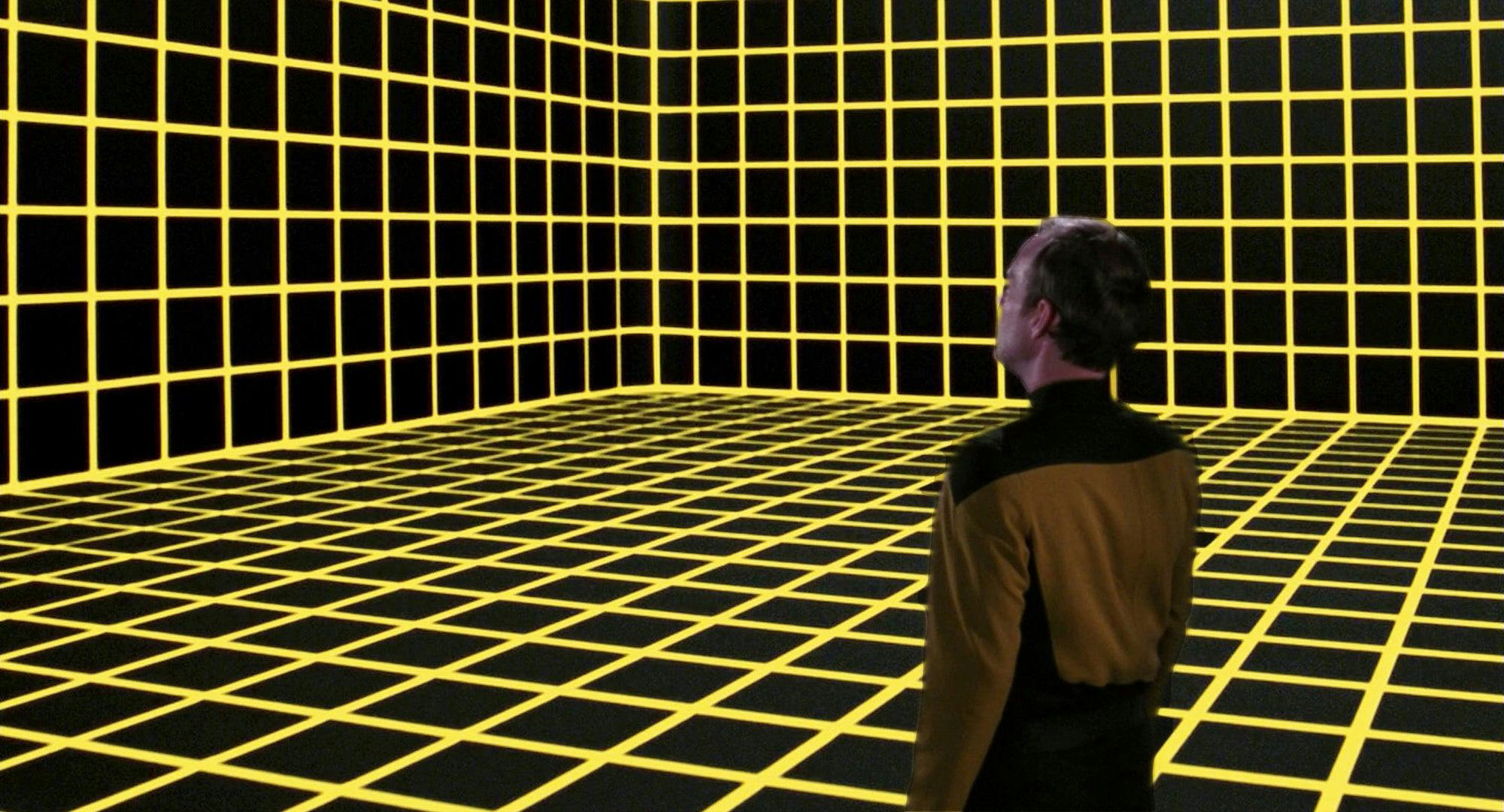
StarTrek.com
More than just a cosmic science-fiction journey, Star Trek often sets the stage for weird and wonderful technology. If you’re reading this on a smartphone or a tablet, you’re holding definitive proof that an array of innovations represented on the show have managed to go beyond the drawing board.
Some Star Trek gadgets, like video chat screens, are well established. Others are on their way, such as a prototype of a dermal regenerator . Here are 10 other futuristic yet topical Star Trek inventions that may one day follow in their footsteps.
1. Fully Realised Holograms
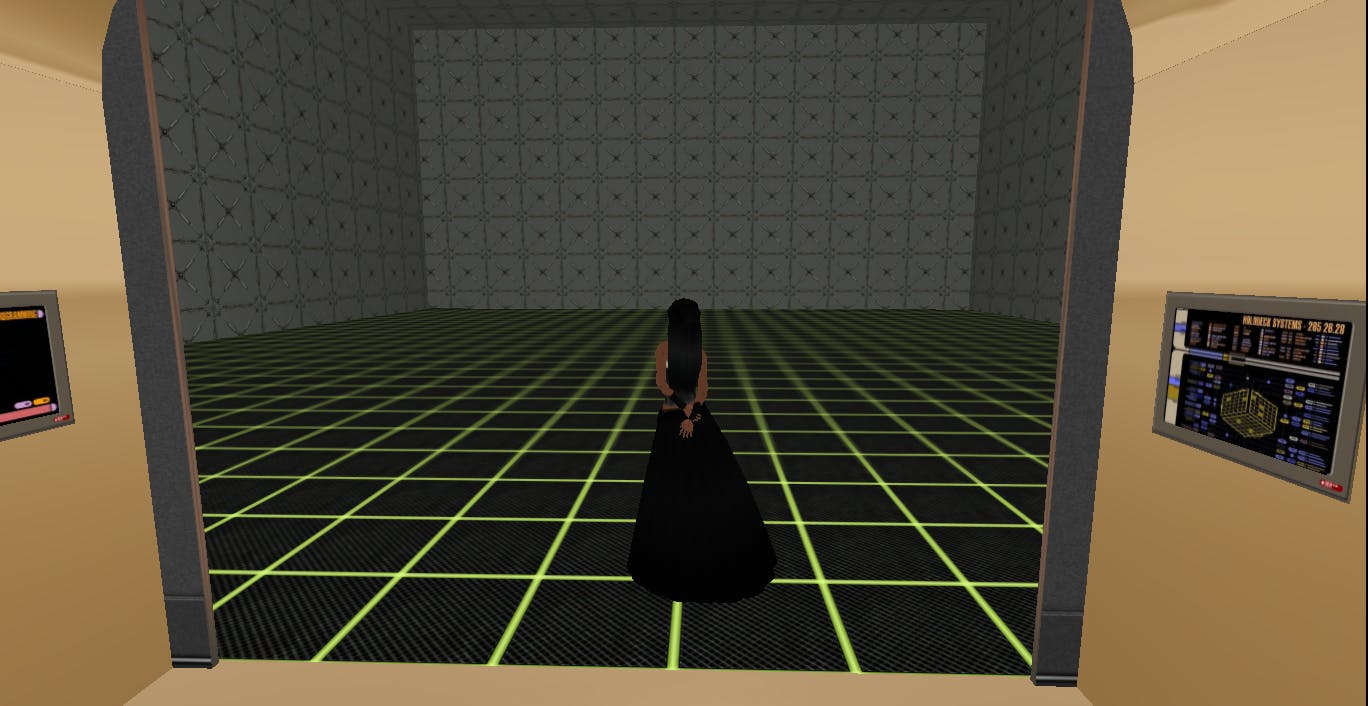
The holodeck, Star Trek ’s ultimate simulator serves as a stage for various life-like virtual reality environments: woodlands, ski slopes, and interactive scenarios featuring fictional characters. In a similar spirit, a team of scientists from Bilkent University, Turkey, has demonstrated the touted first realistic three-dimensional holograms viewable from any angle . "We achieved this feat by going to the fundamentals of holography," said the paper's first author, Dr. Ghaith Makey. His team's immersive 3-D luminous shapes stem from creating hundreds of “image slices,” which are used to rehash a scene in much of its original complexity.
2. Pilot Smart Earbuds

Waverly Labs
Captain Kirk uses a handheld translator to chat with the cloud-like alien entity, The Companion. In a similar vein, devices that translate conversational dialogue in real time are emerging, spurred by advances in artificial intelligence and cloud computing. Witness the Pilot Smart Earbuds designed by New York City tech startup Waverly Labs . Still at pre-launch stage, the projected Bluetooth earbuds can handle 15 languages (excluding Klingon). Online data centers process the conversations as they happen, and translations are sent to both sides engaged in the dialogue, who wear one earbud apiece.
3. 3D Printer
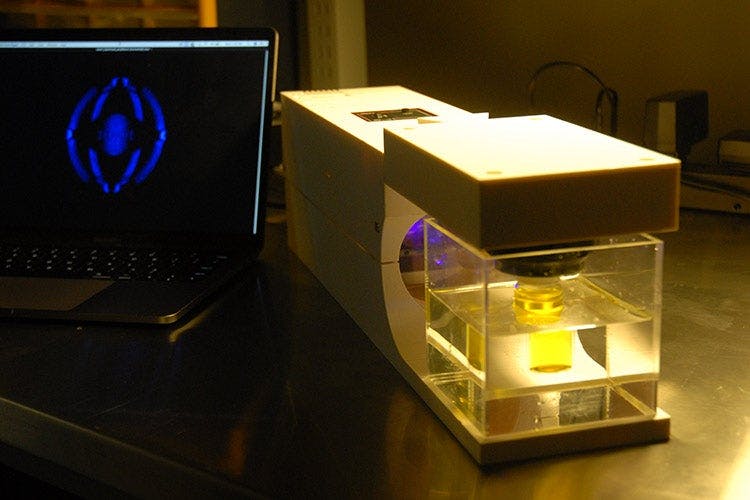
Berkeley University
A replicator can create a world of useful things on demand — capable of cranking out Starfleet uniforms, spare parts, toys and more. Similarly, University of California Berkeley researchers have built a three-dimensional printing device that makes objects appear, seemingly from nowhere. UC Berkeley's replicator makes fully formed objects by leveraging technology designed for pinpoint radiation delivery to cancer patients. The basis of Berkeley's replicator is a projector that casts a series of two-dimensional images through a rotating vial hosting a photosensitive gel. The device can produce complex items, such as a centimeter-size copy of Rodin’s classic ‘The Thinker’ sculpture in minutes.
4. The MinION DNA Tester
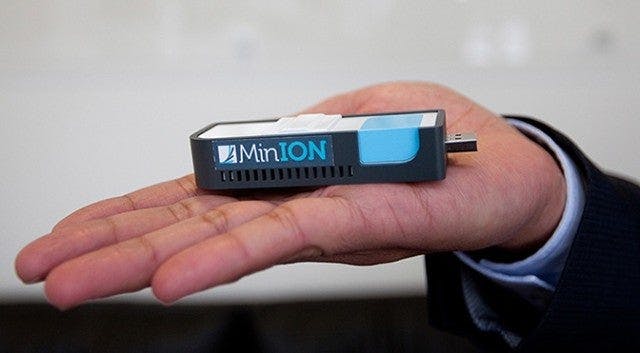
Oxford Nanopore Technologies
Legendary Star Trek doctor Leonard McCoy uses a tricorder to diagnose medical conditions in a snap. Now, a real-world handheld DNA tester called MinION can recognize the Ebola virus and genetically profile tumors, among other uses. The size of a smartphone, MinION is made by UK-based Oxford Nanopore Technologies . The device just needs a tissue sample, from which to tap DNA, and a laptop, but it could be a game changer, Shaili Johri, a post-doctoral biology researcher at San Diego State University, told National Geographic .
5. High Tech Phasers

A Star Trek phaser is a sophisticated weapon. The stream of pulsing energy it discharges can be adjusted so that the target is just shocked or stunned. In reality, just 10 or 12 years ago, a similar laser weapon device was absurdly large: the size of a building, but the U.S. military has developed a breakthrough phaser-like weapon that can be carried on a vehicle. "The technology is continuing to rapidly advance”, Rob Afzal, senior fellow for Laser Sensor and Systems at Lockheed Martin, told Tech Republic . “And we're continuing to work on the systems that you need to deploy a high-powered laser and make it effective like being controlled and getting it onto a platform," Afzal said. On the subject of a real handheld phaser, Afzal added that Lockheed would get there one day.
6. The 'Plane of the Future'
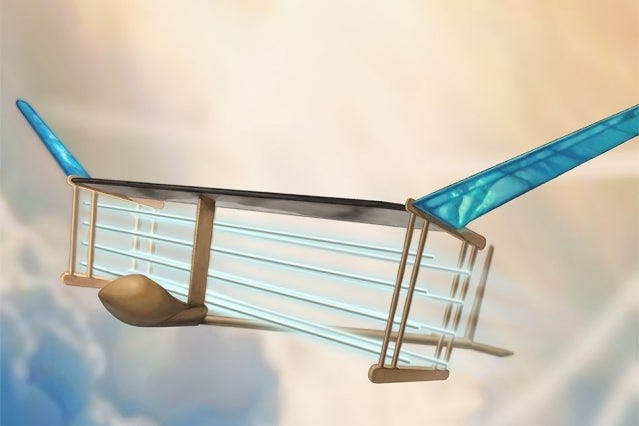
Christine Y. He // MIT
Star Trek shuttles glide through space with the minimum of fuss and no apparent moving parts, and now scientists have created a similar craft that flies using no fuel, just "ion thrusters". The silent, lightweight, plane of the future powered by charged particles owes its existence to Massachusetts Institute of Technology (MIT) scientists. MIT aviation expert Steven Barrett has said he was inspired by Star Trek , which he watched keenly during his childhood. Those shuttle crafts that skimmed the air without obvious moving parts, noise or exhaust captured his imagination.
7. eSight 3
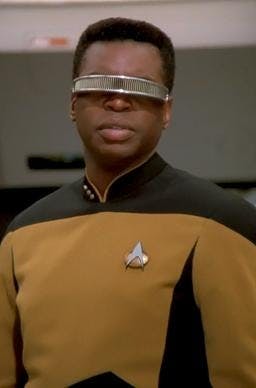
The Next Generation ’s Geordi La Forge is blind but wears a device called a VISOR that provides vision. Similarly, real-life headset called the eSight 3 helps the legally blind see again. The device features a camera that works with high-resolution displays and optical prisms in the headset to restore sight to those with poor vision. "I remember putting them on and looking up and I saw my husband who I'd been married to for eight years and had never seen before," eSight 3 user Yvonne Felix told CNET .
8. Spectral Cloaking

A fictional starship can be rendered invisible by a cloaking device that uses selective bending of light. Canadian National Institute of Scientific Research innovators have built a device that can make things seem to disappear. The Canadian innovation achieves this epic feat by tweaking light wave frequencies. The technique is known mysteriously as “ spectral cloaking .”
9. The LDAL
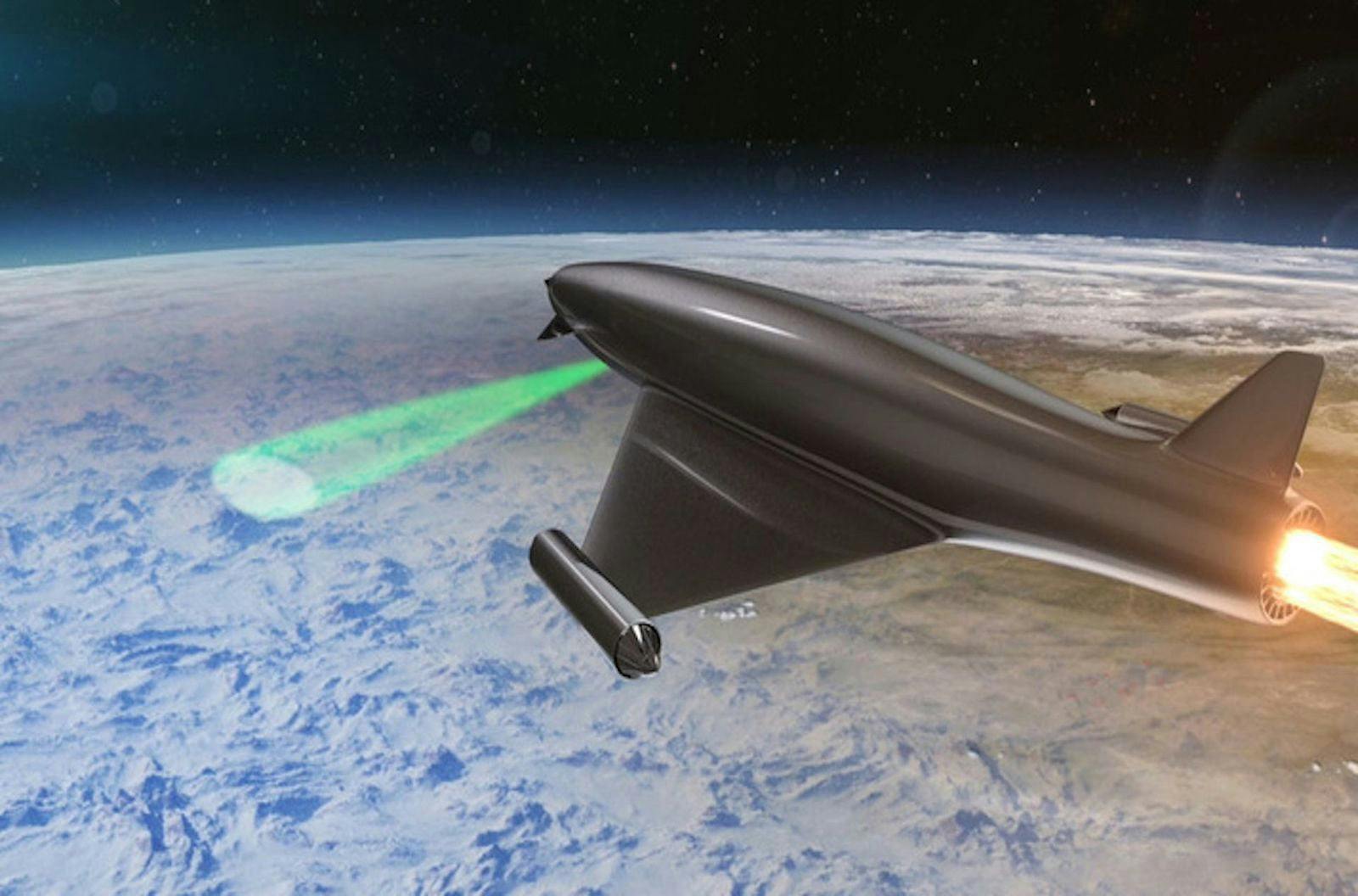
BAE Systems
A Star Trek ship, space station or planet may be protected by a mysterious force field that acts as a shield. Now, the British defense contractor BAE Systems is on a mission to create the same. The innovation, called Laser Developed Atmospheric Lens (LDAL), will supposedly have the ability to deflect lasers aimed at aircraft by ground weapons. LDAL will do this by temporarily ionizing the atmosphere to create lens-like structures that act as refractive shields. The technology — some of the most out-there in this list — may be battlefield-ready in half a century.
10. Atom Transporter
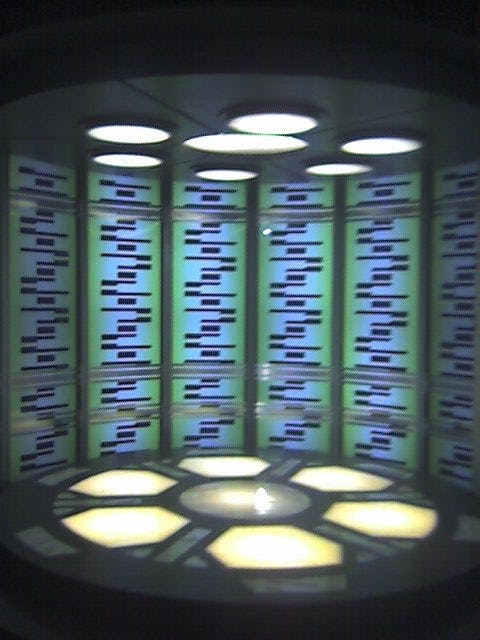
The most dramatic device on the set — the transporter — beams passengers from one spot to another in a flash. While a fully functional transporter appears to be a long way off, a single atom can now be shunted from one spot to another, according to University of Maryland biophysicist Chris Monroe , whose lab contains an array of lasers, mirrors and lenses spread across a table. With the kit, Monroe and his team suck the guts from one molecule, atom A, and implant its essence in atom B. “From the perspective of physics, it's the same as teleporting atom A across the table,” writes NPR analyst Geoff Brumfiel.
David Wilson (he/him) grew up enthralled by Captain Kirk, Spock and Bones. Based in the Asia Pacific, he specializes in reporting weird-and-wonderful tech and business.
Get Updates By Email
6 ‘Star Trek’ Technologies That Exist Today
The future is now
By Mary Beth Griggs | Published Jul 21, 2016 11:29 PM EDT
The world seen in Star Trek movies and shows is meant to take place hundreds of years in the future. And while we’re still waiting on warp drives and transporters some of the technology portrayed in the shows as wildly futuristic is available now. Here are some examples of technology that’ve taken the fiction out of science fiction in the 50 years that Star Trek has been around.
Cell Phones
One of the most remarkable technologies seen in the 1966 original series was the communicator. Carried by crew members on away missions, all a Starfleet officer had to do was flip open the gold lid and speak into the device to instantly connect with distant crew members, either in different places on the planet or onboard the orbiting ship. At the time, when phones were still tethered to walls with wires, it was a cool, futuristic idea.
Get Smart , a spy TV show that aired around the same time as The Original Series , was also experimenting with phones hidden in various places in clothing, from shoes to glasses. Luckily for us, it was the communicator-like cell phones that won out. Talking into a shoe? No, thanks. Even though we’ve moved on from the flip phones toward even smarter, sleeker phones, and moved from talking to texting, the principle of communicating over long distances with small wireless devices endures.

Paper was so passé on Star Trek . Instead of using dead trees, almost all information was relayed and recorded digitally, much like we do today. Their version of tablets were PADD’s, tablet-like devices that were used to read reports, books, and a variety of other information including floor plans and diagnostics. Unlike our tablets, they didn’t seem to hold much information (in several episodes, characters can be seen carrying multiple PADDs for a single meeting or assignment) and seemed to be mostly one-purpose items — think Kindle, not iPad.

Smart Watches
Almost everything about Star Trek: The Motion Picture was terrible. The pacing, the plot, and for the love of Kahless, what was happening with those costumes?! One of the few bright spots was the apparent introduction of wearables in the form of an Apple Watch lookalike that appeared on the characters’ wrists as a part of their uniform.
Just like the communicator, Star Trek wasn’t the first show to come up with the idea. Dick Tracy had a remarkable smart watch back in 1946 , but at least in the world of Star Trek: The Motion Picture , smart watches were a standard part of life, not just reserved for police detectives.
Bluetooth Earpieces
Lieutenant Nyota Uhura, the original communications officer, seemed to be constantly attached to her earpiece, through which she received all kinds of information across various frequencies. Though set in the future, the inspiration for the device likely came from the past. Telephone switchboard operators had been using hands-free headsets for decades when Star Trek debuted in 1966.

Telephone Operator
What was novel about Uhura’s device was that it was completely wireless, transmitting sound into her ear just like Bluetooth devices do today.
Virtual Assistants

Amazon Echo
At the time that the first Star Trek episode came out, computers were massive machines that couldn’t really do that much (at least, not by our standards). The crew of the Enterprise being able to simply talk to the air, ask a question of the computer, and swiftly get an answer was remarkable. Today, many people have that capability on their phones with Apple’s Siri, or in their homes with Amazon’s Alexa. Neither of them are quite at the same level of Majel Barrett-Roddenberry’s computer, but they’re getting eerily close.
Video Calls

Putting an incoming call onscreen happened amazingly frequently in Star Trek . Captains could see adversaries and allies face to face, even while standing on different starships or planets. By using video calls, Star Trek was building on a technology that had been dreamed about for years, and had actually made some progress in the real world. The first commercial ‘Picturephone I’ debuted in 1964 but failed to take off. Today, video calls are no longer novelties, but a part of life.
From Skype, to Facetime, to more professional video call software, it’s no longer unusual to get video messages, or have video calls in real time. While video services haven’t replaced phone calls or the typed word as a way of communication, it’s still pretty common to see the tech being used in classrooms, government conferences, and even just to keep in contact with distant friends or relatives.
Like science, tech, and DIY projects?
Sign up to receive Popular Science's emails and get the highlights.
- Skip to primary navigation
- Skip to main content
- Skip to primary sidebar
- Skip to footer

Tech Trends
Latest Technology News, Blogs & Analysis
Tech Hyposprays Star Trek Technologies Tractor Beams Transporters
Five Star Trek Technologies That Actually Exist Now
May 16, 2019 by Naomi Smith Leave a Comment
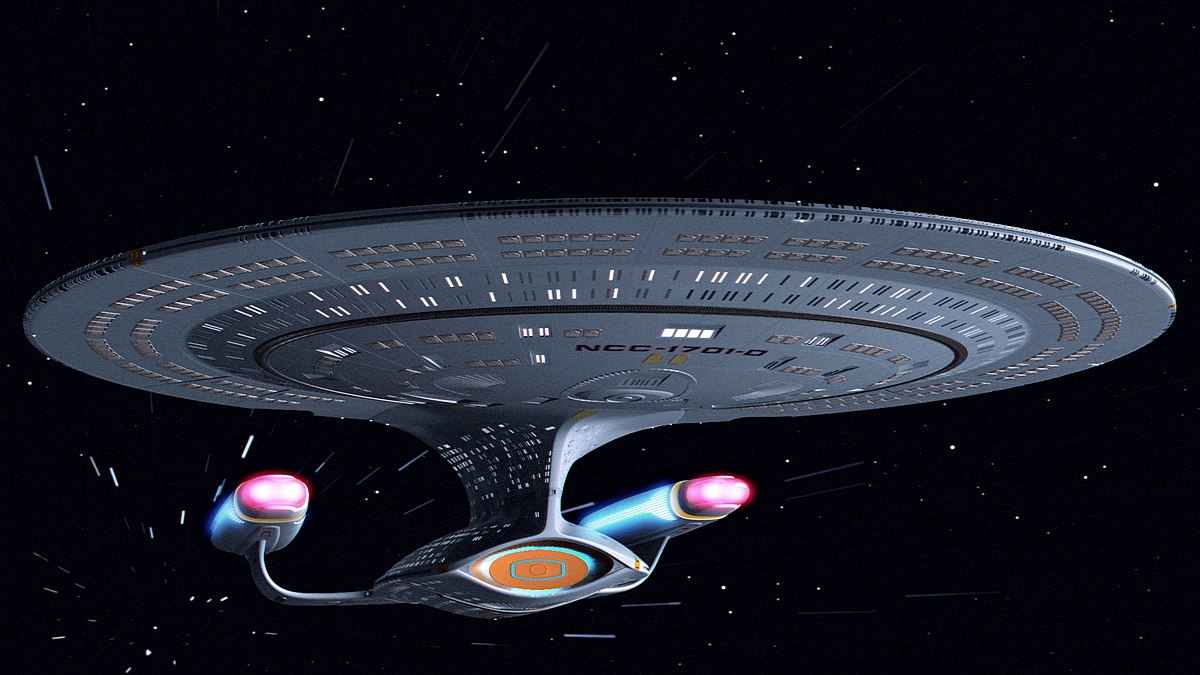
When Star Trek: the Original Series first premiered on 8 September 1966, it was ahead of its time in many respects, optimistically forecasting a future with people of all races (eh, most races) cooperating towards a shared goal: to explore the vast wonders of the universe we inhabit together.
It posited that, following a third world war, humanity would come together to form a single world government, make huge advancements in human rights and develop technologies that would allow us to traverse the stars at lightspeed.
We haven’t quite got there yet (and hopefully we can do it without the war part, although it’s not looking too promising) but Star Trek creator Gene Roddenberry’s most famous work has gone on to inspire the creation of some of the technologies that we take for granted today – and, in some cases, even rely on to function on an everyday basis.
Communicators
This is perhaps one of the most obvious examples of technology that seemed completely farfetched back in Rodenberry’s day but that many of us would struggle to survive without in the modern world. Star Trek’s communicators – not the badges of later series but the original flip phone style ones of the Kirk era – were clear precursors for the modern mobile phone.
Martin Cooper, the man often credited with the invention of the first viable mobile phone, has publicly stated that he was inspired by Star Trek’s communicators and phone developers went on to create flip phones that looked very much like those used by the crew of the Enterprise.
This technology actually predates Star Trek. In the real world, we call hyposprays – a form of hypodermic injection of medication used to deliver inoculations and other medicines – jet injectors. Originally designed for mass vaccinations, jet injectors are safer and faster than standard needles in administering vaccines.
They work by subcutaneously injecting a liquid vaccine, using high air pressure to shoot it deep enough under the skin that no needle in required. They’re similar in appearance to the kind of paint guns we use on cars and use a larger container for the vaccine, allowing doctors and other medical personnel to quickly inoculate large numbers of people.
Transporters
Beam me up, Scotty! Kirk never actually said this famous line in the television show but the iconic transporter beams featured in just about every episode, reportedly because Roddenberry didn’t have a large enough budget to build a shuttlecraft set but needed a way to quicker transport characters from one place to another.
While it’s unlikely that we’ll ever be able to move a human being from one place to another in this way – essentially by disassembling a person on the atomic level at one end and reassembling them in the same order at the other – we have technically achieved teleportation of photons (light particles) and atoms. However, the particles don’t actually disappear and reappear – an exact copy appears at the destination, while the original is destroyed. Human beings consist of around 15 trillion cells so it’s unlikely that this method is going to work for human teleportation – and we’d still have to destroy the original, which seems impractical at best and unethical at worst.
Tractor Beams
The ability to tow an entire starship (if we ever manage to invent such a thing outside of science-fiction) using a tractor beam still sounds out-of-this-world impossible but two New York University professors are working on it nonetheless, using a light beam to control tiny microscopic particles. These are basically optical tweezers aka small lasers focused into beams capable of manipulating molecules and moving them with precision, suspending them in an optical trap.
And in 2015, a team of UK-based engineers announced to the world that they’d invented a way to use soundwaves to move tiny objects of up to 5mm in size without physically touching them. They believe such technology in its current form has a lot of potential for medical usage, and expect that further study will lead to the development of larger, more powerful tractor beams that can move heavier objects in the future.
Reader Interactions
Leave a reply cancel reply.
Your email address will not be published. Required fields are marked *
Friend's Email Address
Your Email Address
- The Inventory
Support Quartz
Fund next-gen business journalism with $10 a month
Free Newsletters
Here are all the technologies Star Trek accurately predicted
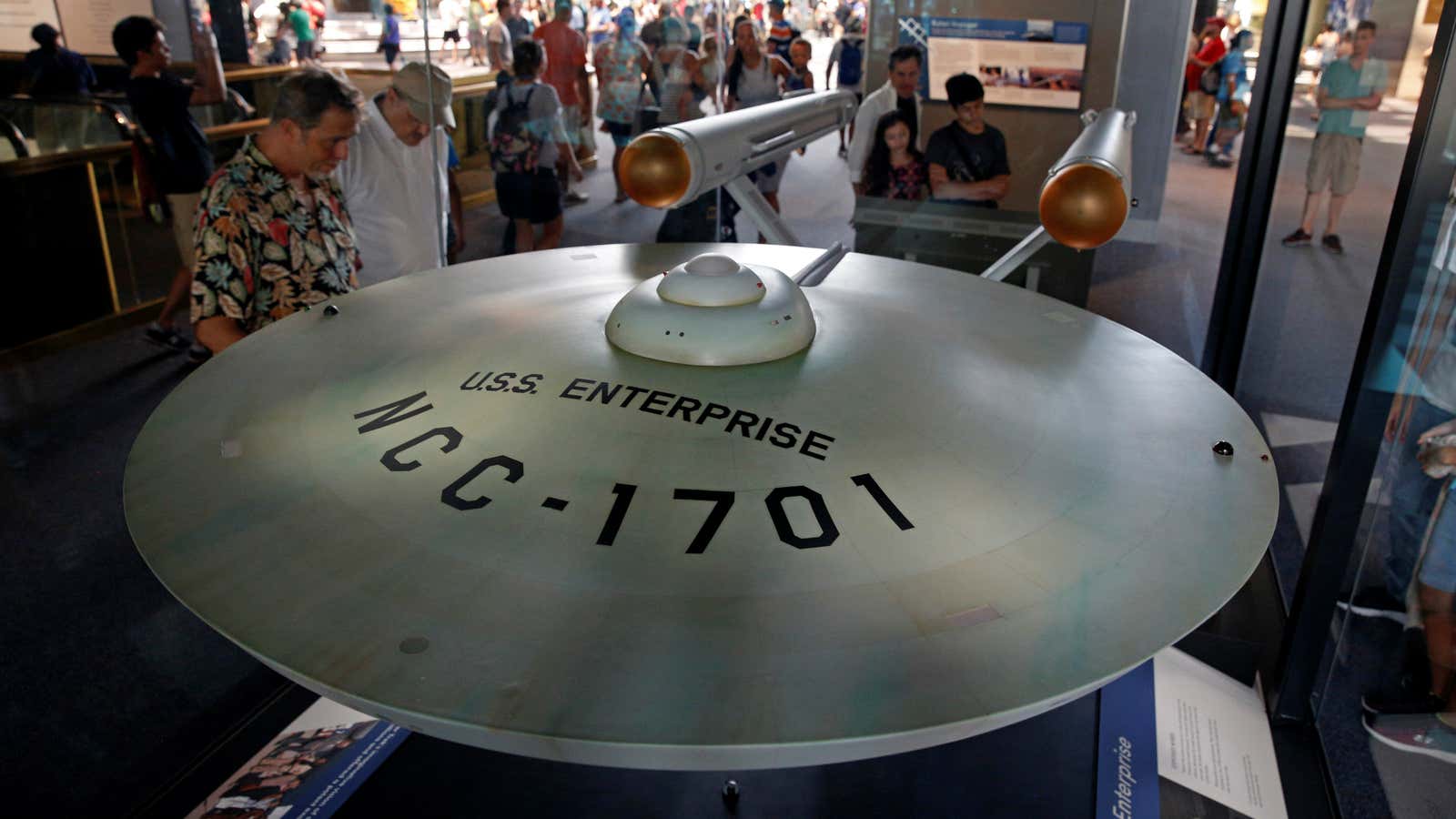
On September 8, 1966, NBC aired the first episode of a new TV series about a starship on a five year mission of space exploration. Today, Star Trek turns 50.
The first episode told of an endangered shape-shifting, salt-sucking alien posing as a human woman to lure prey to its lair. (The creature was killed rather than added to the red list ). Half a century, 726 episodes, four spin-off series ( a fifth is on its way), and 13 movies later, we’ve yet to meet any metamorphosing salt vampires in real life.
On the other hand, a surprising number of fanciful ideas and technologies that appeared on the show over the years have come to pass in the real world. Star Trek , it seems, is one of the great augurs of 21st century living.
Some technologies, like flip-phone communicators, are the fairly predictable result of fiction inspiring fact— Star Trek is a commonly cited influence for scientists. Others, like transparent aluminum, are things even Mr. Spock couldn’t have seen coming.
Here’s a list of all the real-world tech, presaged Star Trek , we could find:
- Tablet computers
- Tractor beams
- Tricorders (there’s also an X Prize for that)
- Flip communicators ( and wearable badge communicators )
- Replicators
- Cloaking devices
- Voice interface computers (hello Siri)
- Transparent aluminum
- Bluetooth headsets (Uhura had one first)
- Google Glass
- Portable memory (from floppy disks to USB sticks)
- Focused ultrasound technology
- Biometric data tracking for health and verifying identity
- Automatic doors
- Big screen displays
- Real-time universal translators
- Teleconferencing
- VISOR bionic eyes for the blind
- Diagnostic beds
There are a few technologies we’re still waiting for:
- Warp drives/matter-antimatter power
- Transporters (“Beam me up”)
- A moneyless society
- The Vulcan nerve pinch
Scientists, make it so.
📬 Sign up for the Daily Brief
Our free, fast, and fun briefing on the global economy, delivered every weekday morning.
Pocket-lint
Star trek in real life: best starfleet gadgets and toys you can buy.
Trekkies have a lot to be excited about right now. There's a new TV series coming soon in the form of Picard and it looks awesome. We're celebrating.
Trekkies have a lot to be excited about right now.
There's a lot of Star Trek content to soak in including Star Trek: Strange New Worlds , Lower Decks and Picard . So it's a great time to be a Star Trek fan.
So, to help you savour the moment (and possibly go where no man has gone before), we have compiled a gallery full of Star Trek-themed gadgets and toys, including everything from cosplay-worthy TNG pyjama sets to a Bluetooth-enabled Original Series communicator.
That's right - say it with us: shut up and take my money!
Star Trek Phaser Universal Remote Control
Arm yourself with the pinnacle in remote control geekiness – a universal remote control built to look like a phaser from the original Star Trek series.
Set phasers to standby and arm yourself with the pinnacle in remote control geekiness – a universal remote control built to look like a phaser from the original Star Trek series.
Another must-buy for classic fans and a brilliant addition to your AV gear setup as well.
The Wand Company Star Trek Original Series Phaser Universal Remote Control Prop Replica
Live long and prosper watch.
Not only does it look great but it also comes engraved with the "Live Long and Prosper" motto.
There are quite a few Star Trek-themed watches out there, but few are as snazzy or stylish as this one. Not only does it look great but it also comes engraved with the "Live Long and Prosper" motto.
The Bradford Exchange Star Trek: Live Long and Prosper Men's Collector Watch
Star trek tng communicator badge.
Much more than just a badge, this is a real working communicator. Of course, you need a smartphone to support it, but otherwise, it's fairly awesome.
Much more than just a badge, this is a real working communicator. Of course you need a smartphone to support it, but otherwise, it's fairly awesome.
This little communicator pairs with your phone via Bluetooth and allows for hands-free phone calls as well as working with music playback and things like navigation apps too. Add to that the classic communicator chirp sound effect and you've got a real winner.
Klingon Bat'Leth replica
Something a little more menacing - a 1:1 scale Sword of Honour replica. This is an officially licenced Klingon Bat'Leth replica that could be yours to own.
Now for something a little more menacing - a 1:1 scale Sword of Honour replica. This is an officially licenced Klingon Bat'Leth replica that could be yours to own.
Just be warned, it's not cheap, but then it is crafted from high-grade aluminium and boasts a genuine split leather grip and a cold cast resin display stand. Plus it looks awesome too.
NECA Star Trek The Next Generation Klingon Bat'leth Foam Prop Replica
Locutus of borg funko pop action figure.
Other than perhaps Picard himself, is there any other icon character from TNG that Locutus of Borg?
Other than perhaps Picard himself, is there any other icon character from TNG that Locutus of Borg?
Certainly, a memorable one and a great vinyl action figure to own if you're a fan of The Next Generation. Resistance is, after all, futile.
Funko POP TV: Star Trek The Next Generation - Locutus of Borg Action Figure
Phaser activated mood light.
You have to be a real Trekkie to know what this one is.
You have to be a real Trekkie to know what this one is:
"This Original Series Star Trek Rock Mood Light faithfully reproduces helmsman Sulu’s thrilling Alfa 177 planetary experience, where he used his phaser to heat a rock and thus save him and his away team from perishing in the freezing conditions."
Another cool little tribute to the show lovingly crafted by The Wand Company that you can see in action before you buy.
The Wand Company Star Trek The Original Series Rock Mood Light - Remote Controlled by Type-1 Phaser
Bluetooth communicator.
Every fan of the original series of Star Trek has no doubt dreamt about owning a real communicator.
Every fan of the original series of Star Trek has no doubt dreamt about owning a real communicator. In 2016, The Wand Company released an officially licensed Bluetooth Communicator that pairs with your smartphone so you can make and receive calls like Captain Kirk himself.
This nifty little communicator is jammed full of awesome features like wireless charging, authentic sound effects, a quality speaker and MEMS microphone. What could be more awesome than this, other than a working teleporter of course.
The Wand Company Star Trek Communicator - Connect To Your Phone Via Bluetooth To Answer Phone Calls Or Play Music On This Sleek Zinc & Metal Replica
Captain kirk bookend.
Not easy to get hold of anymore, but perhaps the coolest addition any Trekker could add to their bookshelf.
Not easy to get hold of anymore, but perhaps the coolest addition any Trekker could add to their bookshelf. A bookend that features Captain Kirk, in the Captain's chair, looking deep in thought.
USS Enterprise telephone
We suspect that not many people use landline phones anymore, but if you're one of the few that do, then this is an awesome purchase.
We suspect that not many people use landline phones anymore, but if you're one of the few that do, then this is an awesome purchase. A phone styled after NCC-1701. Make a call with the future.
Enterprise pizza slicer
Satisfy your craving for pizza while also showing off your love for Trek with this Enterprise pizza slicer.
Satisfy your craving for pizza while also showing off your love for Trek with this Enterprise pizza slicer.
"The Star Trek Pizza Cutter has its mission to explore strange new pizzas, seek out new toppings and cheeses, and boldly cut pizza where no man has cut before."
Star Trek: The Original Series USS Enterprise NCC 1701 Pizza Cutter Utensil
Star trek business card holder.
Wear your geek right on your sleeve with this Trek-styled business card holder.
Wear your geek right on your sleeve with this Trek styled business card holder. Will business cards still be a thing by the time Federation is established? Doubtful. But in the meantime, you can carry out business in style.
Star Trek: TNG scarf and hat
What about a fancy scarf emblazoned with the Starfleet logo and classic colours from The Next Generation?
Looking for something Trek-themed to keep you warm in the cold winter weather? What about a fancy scarf emblazoned with the Starfleet logo and classic colours from The Next Generation?
STAR TREK: The Next Generation Command Scarf
Star trek science emblem clock.
Keep on Trekking, all the time, with this wall-mounted Starfleet clock. It's big, bold and beautiful and it doesn't even break the bank either.
What time is it? It's Trek time. Keep on Trekking, all the time, with this wall-mounted Starfleet clock. It's big, bold and beautiful and it doesn't even break the bank either.
Star Trek USS Enterprise sushi set
Yes, there is essentially a Star Trek themed item for basically anything you can think of. Even eating raw fish.
Yes, there is essentially a Star Trek themed item for basically anything you can think of. Even eating raw fish. Dip your fish and rice combo into the hull of the USS Enterprise and get a great taste in style.
Star Trek U.S.S Enterprise Sushi Set
Star trek cookie cutters.
There's no denying these Star Trek themed cookie cutters are awesome. Set replicators to delicious and get yourself some tasty snacks.
You might be getting the impression we're obsessed with food or at least that gadget companies think Trekkies are. But there's no denying these Star Trek themed cookie cutters are awesome. Set replicators to delicious and get yourself some tasty snacks.
Star Trek electronic door chime
Another awesome addition to your home comes in the form of a motion-sensitive door chime that makes a sound every time someone crosses the threshold.
Another awesome addition to your home comes in the form of a motion-sensitive door chime that makes a sound every time someone crosses the threshold.
This gizmo also features a classic door opening sound effect and even a red alert alarm. Not quite enough? How about a button that activates the Communicator Whistle?
Star Trek bathrobes
What better way to slob-out and binge some classic Trek episodes than in an uber comfortable, super soft and awesome-looking bathrobe?
Various versions are available, some even include the rank pins for a real sense of authenticity.
Star Trek The Next Generation Picard Costume Adult Fleece Plush Robe Bathrobe -OSFM
Original series tricorder.
This is a replicator Tricorder that's based on the classic 23rd-century design.
This is a replicator Tricorder that's based on the classic 23rd-century design. An electronic Science Tricorder that you can own and use in your own home (or on missions in the galaxy).
It features light-up buttons, sound effects and classic style. There's even a removable scanner accessory - perfect to take with you on your next away mission!
Star Trek uniformed coloured messenger bags
These bags are great for those not afraid to show their love for Star Trek.
These bags are great. Not only do they help you boldly go wherever you've been (or not been) before, with the Starfleet logo loudly and proudly displayed for all to see. But they also let you show off your rank as they're available in the different uniform colours including gold, red and green.
Star Trek TNG Command Uniform Bedding
Upgrade your bed with these officially-licensed bedding items that include a red duvet cover and a rank pips pillowcase.
Upgrade your bed with these officially-licensed bedding items that include a red duvet cover and a rank pips pillowcase. Now you can live, breathe and sleep Trek.
Star Trek Discovery Uniform Single Duvet Cover Reversible Bedding Set Official Licensed Merchandise (Star Trek Next Gen Uniform)
Star trek baby onesie.
Get them started early with this awesome baby onesie. You can't be sure they'll be a Trekkie, but you can only try your best.
Get them started early with this awesome baby onesie. You can't be sure they'll be a Trekkie, but you can only try your best. In the meantime, at least they'll be brilliantly dressed.
Popfunk Star Trek I just Boldly Went Baby Onesie Bodysuit (12 mos) Navy
Star trek pyjamas.
Bedtime, the final frontier. Boldly go to bed like no one else has before - sporting some comfortable Star Trek getup that's bound to please.
Bedtime, the final frontier. Boldly go to bed like no one else has before - sporting some comfortable Star Trek getup that's bound to please.
Star Trek Next Generation Men's Picard Uniform Costume Sleepwear Raglan And Pants Pajama Set (SM)
That's right, you can own your Tribble. These are apparently the "softest Tribbles ever made" and are brilliant little furballs.
That's right, you can own your Tribble. These are apparently the "softest Tribbles ever made" and are brilliant little furballs every fan of the original series will love.
The best thing is, they don't cost much so you could buy a load and recreate "The Trouble with Tribbles" in your own home.
Star Trek Plush Tribble - Gray Tundra Tribble - Small Size
Air hogs uss enterprise remote control vehicle.
Let's face it, you're probably never going to get the chance to command your own spaceship, but that doesn't mean you won't get the chance to control one.
Let's face it, you're probably never going to get the chance to command your own spaceship, but that doesn't mean you won't get the chance to control one. This remote-controlled U.S.S. Enterprise should provide some light entertainment for Trek fans, if nothing else.
Mr. Spock Business Card Holder
Need somewhere fancy to keep your business cards or somewhere awesome to display those you've collected from visitors? Then this holder might do the trick.
Need somewhere fancy to keep your business cards or somewhere awesome to display those you've collected from visitors? Then this holder might do the trick. Live long and prosper.
Klingon Watch
It's not the most subtle of watches but if you want to wear your Trek pride on your wrist then what better way to do it? Especially if you're a Klingon fan.
Klingon Watch - Star Trek - Unisex Analog Watch
U.s.s enterprise replica speaker.
Why get a boring non-descript Bluetooth speaker when you could buy one that's modelled after the U.S.S. Enterprise? It'll certainly surprise your house guests when it starts blasting tunes.
Star Trek U.S.S. Enterprise 1701-D – Enterprise Replica Bluetooth Speaker, Engine Noise Sleep Machine, Night Light, Sound Effects – Memorabilia, Gifts, Gadgets, Collectibles for Star Trek Fans
Amazon Walmart
U.S.S Enterprise drone
Sure, DJI might be ruling the skies in the consumer drones market, but Air Hogs is much more thrilling for Trekkies. Just look at this Enterprise remote control drone.
11 Star Trek Gadgets We Wish Were Real
Shoot. Stun. Kill. Here are all the futuristic Star Trek gadgets we wish were real.
The Star Trek universe is full of high-tech gadgets that defy physics, bend reality, and get you to far away places really, really fast. From holodecks that recreate historical situations, to universal translators that allow you to hear an alien language in your own tongue, the tech in Star Trek can only be described as one thing; magical. One of the most interesting things about the Star Trek franchise is how it bases the science fiction of its world on science fact. It's not too far-fetched to imagine a day, perhaps centuries in the future, where most of this tech can be fully realized in one way or the other. With that in mind, here are eleven gadgets from the Star Trek universe that we wish were real, and who knows, maybe one day they will be.
11 The Phaser
An energy weapon that has the ability to modulate its damage output, the phaser is a piece of Star Trek tech that defies the realm of modern physics. While advancements have been made in the use of energy weapons in recent times, a true weapon capable of sending out charged particles of light or plasma with any sort of consistency are still generations beyond us. In Star Trek , phaser energy can be handheld, portable, or utilized in larger systems like the phaser arrays seen on advanced starships like the Enterprise. In service among Starfleet personnel since the 23rd century, phaser weapons can be adapted for close combat use, or large scale space conflicts. While Starfleet is not the only power in Star Trek with access to phaser weapon technology, they stand as one of the more ethically conscious powers that utilize it for combat, granting stun capabilities for smaller threat incursions, that some contemporaries, like the Klingons, see little use for.
Related: Every On-Screen Captain of the USS Enterprise, Ranked
10 The Tricorder
The Swiss army knife of functionality, the tricorder is like having the capabilities of an entire hospital in the palm of your hand, and then some. Tricorders have the ability to heal minor scrapes and wounds nearly instantaneously, administer life-saving drugs, or inoculate against harmful viruses or radiation at the press of a button. But their utilizations are not just contained to the medical arts. Tricorders can also be used as scanners, revealing cloaked targets, or hidden signals otherwise hidden to Starfleet officers, and as archeological tools designed to unearth long-buried civilizations, or cryptic messages. In our modern world, tricorders are more like science fact than science fiction, with real life manifestations that can scan for radiation, serve as spectrometers, or even help patients diagnose medical ailments, albeit in a more specialized function.
9 The Transporter
Beam me up, Scottie! The legendary words of Captain Kirk to his chief engineer officer, Mr. Scott, in the original Star Trek series are forever ingrained in the psyches of Trek fans spanning multiple generations . The transporter has the power to instantaneously beam Starfleet officers, soldiers, and captains to other ships and worlds. Near-instant travel would revolutionize the modern world, eliminating the need for most point-to-point transport, and making cars, trains, and airplanes nearly obsolete. In recent times, scientists have had limited success transporting materials instantly from one destination to the other, focusing on inanimate objects or quantum entangled particles. In truth, transporting living, breathing matter across any distance still remains a step above our current capabilities, and the thought of having ones body taken apart molecule by molecule, then recombined together sounds more painful than even the tech of Star Trek can account for.
8 The Holodeck
In Picard, captain Jean Luc Picard, one of the most legendary captains of all time, uses the holodeck to recreate his family vineyard, and find solace in his ancestral heritage. We see this kind of use across the entire scope of the Star Trek franchise, and of all the Star Trek gadgets; perhaps the holodeck is the one that inspires the most imaginative uses. From exotic destinations that officers can only dream of while serving on Federation Starships, to reenacting famous time periods in history, or even training for combat, the holodeck is a multi-function gadget that would change the modern world if realized in our times. In the more advanced eras of the Star Trek timeline, holograms can be used to defend ships, and even cause physical damage to organic lifeforms. In the real world, we see the first inklings of this technology in use, from three-dimensional billboards that defy our sense of reality, to virtual concerts of past legends that appear all too real to be believed. Still, the holodeck of Star Trek remains light years ahead of our current mark, even as our modern day sciences make warp-like advances.
7 The Starfleet Badge
The Starfleet badge is an iconic symbol of excellence , honor, and the advancement of the human experience across the cosmos. Instantaneous communication, and the ability to track any one individual across space and time is an incredible feat of scientific know-how, and perhaps one gadget that's most closely aligned with our modern day capabilities. It's not hard to relate the abilities of the Starfleet badge to the modern day cellphone, with its ability to triangulate location and send transmissions around the globe. While not instantaneous, the transmission of data in our world is limited to the speed of light. In Star Trek , this cosmic speed limit seems to have been surpassed by savvy tech and the manipulation of physics, that while not insurmountable by current theories of our world, remains elusive to our current understanding of the cosmos. Only time will tell if we can bridge this gap between the fictional world and the factual one, but of all the gadgets in the Star Trek armory, this one seems the most attainable.
6 Warp Drive
The world of Star Trek is full of warp-capable starships that defy physics, and travel faster than light to distant worlds and civilizations. What at first might seem like a convenient plot device meant to suspend our disbelief in a universe of politicking intergalactic civilizations, warp drive actually has its basis in real science, and is underpinned by theories that could result in faster-than-light travel one day. With the reality that the distant light of stars takes millions and billions of years to travel space-time and register in our telescopes, it's clear that the world of Star Trek depends on starships traveling quicker than the limits allowed by physics, even to make sense. Hence, why having a warp drive in our times would be a monumental game changer that would shake the very foundations of human exploration forever. If we could somehow figure out a way to go faster than light, and break the cosmic speed limit, maybe we could stake our place in the universe the same way that Starfleet has.
5 Tractor Beams
A long-held staple of the science fiction genre, tractor beams in Star Trek would revolutionize our modern world. In Star Trek lore, tractor beams are most often utilized to secure other spacecraft, or tow disabled craft to safe harbor, and in some cases, assist in combat operations against hostile craft. While the Federation is one of the more moderately advanced civilizations in Star Trek , other races, like the Borg have even greater tractor beam capabilities, and use it to devastating effect against Federation starships, draining shields and inflicting damage simultaneously. In our times, tractor beam technology would revolutionize the world, allowing us to tow objects through space, and vast distances almost effortlessly. It would also be useful defensively, perhaps serving as a missile shield capable of protecting vital resources, or military installations from attack. We are far away from any real life tractor beam of Star Trek scale, but advances have been made using sound waves to control physical matter; perhaps it's just a matter of time.
4 Universal Translators
Civilizations across Star Trek have developed universal translators to communicate with one another in real time, leaping over the evolutionary barriers of alien languages developed across thousands of different worlds. The universal translator in Star Trek is useful in diplomatic missions, during peacetime and war, but is taken for granted in many instances. We hardly even recognize the tremendous amount of technology that would go into developing such a capability, and its use in Star Trek spans over a hundred years of development, leading to its widespread adoption, and standard issue in Federation starship communications. In real life, a universal translator would truly change the world, allowing people from all over the globe to instantly communicate with one another seamlessly. This tech, while remarkable, is not as far-fetched as it sounds however, with modern advances building on the capability to translate multiple languages in real time, and allow for near instant communication.
3 Replicator
We've all witnessed the crew of multiple Federation starships command the replicator to create food, beverages, parts, or devices in an instant. With the ability to manipulate matter on a quantum scale, the replicator, quite understandably, stands as one of the most important bits of technology in the Star Trek universe. Without this tech, intergalactic travel at the scale of the United Federation of Planets would be impossible, and notably, could single-handedly explain the advancement of human civilization to the point where jobs became a thing of the past. A replicator with the ability to conjure food, medicine, parts, or other vital materials instantaneously would revolutionize our world, and quickly bring a resource dependent economy to its knees, something that Earth, in the times of Starfleet, had already navigated through on its ascension to the exploration of stars.
Related: 10 Star Trek II: The Wrath of Khan Facts You Never Knew
2 Gene Augmentation
If you think gene augmentation is a touchy subject now, wait until you see the fireworks it inspires in future Star Trek eras. With all the tech at the disposal of humanity during the time of the Federation, one might wonder why armies of genetically modified super soldiers didn't overrun the galaxy, or conquer old age, or defy death itself. Well, it's not for lack of trying, if the Eugenics War of Star Trek lore is any indication. The domination of matter, space, time, and even the mastery of medicine itself should've been enough to inspire a genetic revolution, but the augmentation of humanity in Starfleet remains off limits. Even after conflicts with Khan , perhaps the most famous genetically modified human ever, the potential for gene augmentation remains a tempting premise in both science fiction lore, and the real world. With conflict surrounding the use of genetically modified humans highlighted in recent episodes of Star Trek: Strange New Worlds and Picard , this is an issue that continues to divide the political world of Star Trek . Still, god-like powers to augment humanity sure would be nice.
Like the use of genetics, the arguments surrounding the use of androids in Star Trek remain hotly contested. In modern Starfleet, the use of androids is strictly outlawed after a synthetic rebellion put the Federation on high alert. Data, the most iconic android of the Star Trek mythos, remains the golden example of the heights android technology can reach, having developed aspects of his humanity while serving on the Enterprise of the TNG era, and even sacrificing himself for his crew. In our times, a true synthetic life form would, rightfully so, inspire many of the same reservations and concerns that consume the politics of the Federation. Yet, no one can deny the possibilities on society that synthetic lifeforms would have, from creating an endless and expendable work force, to the exploration of consciousness in lifeforms created by the hands of humanity. With so much potential, androids are one gadget in Star Trek that both science fiction and science fact seem destined to tackle, one day.
15 Technologies From Star Trek We Now Have!
Via screenrant.com
Ever since it first debuted in 1966, Gene Roddenberry’s Star Trek has inspired both tech savvy nerds and the general population for decades, with its imaginative and optimistic portrayals of what technology could do to for human society. The original series was set in the late 2260s and its characters sailed between stars at faster-than-light speed, could be teleported to exotic planets, and often made references to a world “free from disease, hunger, and hardship” all due to human invention. In its numerous television and film spin-offs, the franchise writers developed even more seemingly fantastic technologies including food replicators, interactive holodecks, and quantum torpedoes.
At the time many futurists, writers and technologists thought it really would be centuries rather than decades before we would have the tech seen in Trek. Granted, our modern society hasn’t produced all of the amazing inventions seen in the series; however, modern engineers, chemists and computer programmers have done a remarkable job of vastly improving the state of the world which in many ways are at or well ahead of Star Trek’s timeline. The following are just a few of the exciting technological innovations seen in Roddenberry’s legendary futurist series.
15. Tractor Beam
Via pri.org
Used for a variety of functions from manipulating tool to energy tow cable to non-conventional weapon system, the tractor beams of Star Trek have been employed extensively to achieve a variety of ends throughout the canon. Within the series, tractor beams are described as a sort of graviton beam, generated through some described process, and focused and emitted from the Enterprise’s deflector dish. Granted, gravitons are still hypothetical particles and human beings have come nowhere near creating a deflector dish, engineers have none the less developed a sort of tractor beam system.
Although still in its infancy, scientists at the University of Sussex and Bristol have manufactured a tractor beam-like technology which uses high-amplitude soundwaves to manipulate objects in the surrounding environment. These primitive tractor beam generators have a variety of applications as they produce small force fields which can lift small objects and even create “holographic acoustics.”
14. Universal Translators
Via appadvice.com
Traveling interstellar distances and encountering truly alien cultures is perilous enough. Particularly so when they all use different languages. Fortunately, the writers of Star Trek have extensively employed the concept of a universal translator which, after sampling only a little of a foreign species’ language, can decipher and reinterpret the language into English in real time.
Although real-world engineers and linguists haven’t found a means to develop a device to do exactly this (and realistically, they can’t) software developers have devised something very close. TalirApps has released a real-time voice and text translation program available on Apple’s App Store. This nifty application can translate, so far, seventy-one pre-programed languages from around the world.
13. Video Calls
Via startrek.therewatch.com
Back in 1967 everyone in America had the same boring, rotary AT&T telephone set. At the time, it seemed impossible to imagine a far more exciting and exotic means to communicate with people on the other side of a continent, let alone the other side of the planet. Gene Roddenberry and his team of writers conceived of a future wherein people could conduct audio-visual conversations between parties on either side of planets or even between individuals on a planet and a spacecraft.
Not only does nearly everyone with a smartphone have this technology, they can do that without having access to the comparatively bulky equipment of a Federation starship.

12. Diagnostic Medical Beds
Via kethinov.com
Besides a unique take on faster-than-light travel and energy weapons, one of the most innovative technologies showcased on the original Star Trek was the concept of a computer-assisted medical bed. Of course, we have had mavhines for decades which display basic vital statistics (ex. heart rate, body temperature), but recently the University of Leicester has invested three years of development to take the technology one step further.
Incorporating technology developed in the space sector and medical industry has allowed physicians to monitor and analyze a panoply of features. For example, this system monitors not only blood flow but blood oxygenation as well as skin coloration, and exhalation composition. By doing this, the bio-bed can screen for conditions which would otherwise take extensive human observation and testing such as asthma and liver disease, and in so doing reduce the amount of time physicians need to spend with their patients.
11. Big Screen Displays
Via memory-alpha.wikia.com
Back in the sixties, the concept of having large, flat display screens which could accurately render images in full-color really was science fiction. Never mind having these screens be ubiquitous in human society. In fact, when the original Star Trek series aired, only about twenty-five percent of all US households had television sets that could display color video. For decades it had seemed like the only people who would enjoy massive interactive display screens were the bridge crew of the starship Enterprise.
However, in the early nineties the big screen televisions emerged and ever since have become bigger and better with improved features such as “smart” technology and high definition display.
10. Dermal Regenerators
Via getmovienews.com
The military scientists of Star Trek’s Starfleet commonly find themselves on the receiving end of an enormous amount of lacerations, severe burns and general physical abuse while on their perilous journeys. Fortunately, the series writers of Star Trek: The Next Generation developed the concept of the dermal regenerator, a medical device which emits a beam which would instantly seal and heal open wounds without leaving any scars.
Prior to the development of stem cells, the closest thing to this technology was skin grafts which often required physicians to wait for weeks or even months to locate and harvest tissue from a compatible donor or rearrange existing skin on the victim. However, researchers at the University of Granada’s Department of Histology have published a new technique to derive stem cells for skin tissue development. These cells come from the undifferentiated cells in Wharton’s jelly mesenchymal stem cells found in donor umbilical cords. Once these generic cells are extracted and combined with a combination of fibrous protein and a polysaccharide polymer, novel skin cells and mucosal cells found inside the mouth are produced.
The two key advantages to this procedure include the fact that the stem cells don’t need to be painfully harvested from the victim’s bone marrow and the skin tissue cultures, once developed, can be stored for long periods and then be grafted when they are needed.
9. Directed-Energy Weapons
Via startrek-originals.com
While a common staple of science fiction, one of the most flashy aspects of the Star Trek universe are its energy weapons: phasers. But what makes Star Trek’s energy weapons distinct are its humanitarian “stun” setting. Developed by the Raytheon, the Active Denial System is a direct-energy weapon which emits an invisible non-lethal microwave beam to incapacitate a target.
Unlike a traditional taser – and much like Starfleet’s phasers – this system doesn’t require the transmission of energy through a solid medium like darts and coils. Instead, the energy travels in a concentrated 95 Gigahertz beam through the air and excites the water molecules inside the targets top layer of skin. This excitation causes immense pain in the target but doesn’t cause any permanent damage under normal exposure. Current applications include use by the police and prison staff to disperse violent crowds without using any potentially dangerous non-lethal crowd control methods such as rubber bullets, water cannons or tear gas. The US military has also expressed interest in using this system as a means to quell civil unrest without injuring or killing civilians.
8. Orbital Skydiving
Via TrekMovie.com
While most people may not be aware, the seventh Star Trek feature film, Star Trek: Generations’ opening scene was supposed to feature Captain Kirk in a daring, recreational dive from outer space through Earth’s atmosphere. While the footage was cut from the film, the concept was later recycled and mentioned as a recreational activity in the series Star Trek Voyager and used as a battle tactic in the franchise’s 2009 cinematic reboot.
Technically, high-atmosphere skydiving is older than Star Trek itself, but successfully and safely free-falling through the upper atmosphere has been a recent development. In the mid-1960s Nick Piantanida failed to break Air Force Colonel’s Joseph W. Kittinger’s 1960 high-atmospheric 31-kilometer fall. In an attempt to dive from 37-kilometers Piantanida barely survived a 17-kilometer drop and ended up suffering brain damage and was rendered comatose.
However, in 2012 Felix Baumgartner broke this record by safely falling 39 kilometers and also ended up breaking the sound barrier towards the end of his descent. What’s unique about this jump is that it was funded in part by a private company, Red Bull, and rather than be conducted in secret by the military, this jump was publicized as both a recreational and promotional event. Two years later, Alan Eustace beat Baumgartner’s world record with a 41-kilometer dive.
7. Deep-Space Research Platforms
Via ditl.org
The core premise of Star Trek is the exploration of uncharted space on warp-capable starships. However, the franchise’s characters learn about the universe through other means including the use of advanced deep-space arrays such as the 1.6 kilometer Argus array.
While humans have never built something of that size, they have built and launched several sophisticated probes which study both nearby and distant stellar bodies; most famous among these is the Hubble space telescope. Since its launch in 1990, Hubble has observed myriad objects 13.4 billion light years away and has generated over 120 terabytes of data.
6. Bionic Eyes
Part of Gene Roddenberry’s vision was to develop a science fiction universe in which nearly anything, even the most debilitating medical condition, could be overcome through technology. One of his characters, chief engineer Lieutenant Commander Geordi La Forge from Star Trek: The Next Generation , was born blind but had his sight restored at the age of five via a VISOR, or Visual Instrument and Sensory Organ Replacement. Said device is an arc-shaped prosthesis which enables the wearer to detect not only visual light but electromagnetic wavelengths above and below the visual spectrum and send the signal directly to La Forge’s brain.
Myriad devices similar to this have been developed since TNG was first launched in the eighties. Among them are William Dobelle’s glasses developed during the end of last century which have partially restored sight in some individuals who’ve been blind their entire life. More recently, Dr. Robert Shepherd and his colleagues at Bionics Institute of Australia have developed a far more hi-tech visual prosthesis and is specifically designed for those who suffer from the leading cause of blindness, retinitis pigmentosa. The bionic eye consists of multiple electrodes which have been wired into the brain and eyes to stimulate the surviving retinal cells. The electrochemical signals that the still-living cells receive from the environment are relayed back to the brain’s vision centers and a synthetic vision processor. These signals are then combined to restore vision allowing patients to read large font print and resolve large objects.
5. Planet-Wide Networked Communications
Via trekcore.com
Generally speaking, even the most imaginative science fiction writer didn’t see the world-wide web coming. However, writer Robert Hammer and Gene L. Coon did develop a similar concept when writing the original series Star Trek episode “A Taste of Armageddon”. The plot of the episode centers on a planet, Eminiar VII, whose inhabitants are locked in an interplanetary conflict with their neighbors, the Vendikar. Rather than engage in traditional warfare, both planets use computers to simulate war games on a planetary scale. In order to save the infrastructure of both planets, the ordinance used is virtual but “causalities” which have been “hit” in certain metropolitan areas are required by treaty to report to disintegration chambers.
While not exactly the internet as we have it now, this was one of the first examples in televised science fiction of planet-wide networked communication. Of course, our world-wide web is used for far more constructive ends. In fact, the adoption of the internet has been a massive economic boon for companies in both high- and low-income countries all over the world, and is slated to further boost economic growth by nearly four to over eleven trillion dollars by the year 2025. This example is one wherein the real world has actually drastically outpaced Star Trek.
4. Voice-Interactive Computers
Via fortune.com
One of the most distinguishing tropes established by the Star Trek franchise is the voice interactive computer. On Star Trek, everything from food replicators to starship computer cores can be accessed with only a person’s voice. Of course, in our world, handheld voice-interactive user interfaces such as Siri and Cortana are ubiquitous, but technologists are pushing this technology even further.
Craig Nevill-Manning is developing a phenomenal new update for Google: a wholly voice-activated interface. In addition to performing traditional search-engine queries, the upcoming “Star Trek computer” will locate data, analyze it, and give the user personalized answers or advice based on the user’s question from both desktops and mobile devices.
3. Medical Tricorders
Via redshirtsalwaysdie.com
What would Star Trek be without the handheld tricorder devices which are able to tell you nearly everything about the environment around you but leave out just enough information to drive the plot forward? A specialized form of this device is the medical tricorder which would allow Dr. “Bones” McCoy to assess a patient’s condition and diagnose everything from a case of Andorian shingles or contraction of the Auroral Plague.
As a result of the Qualcomm Tricorder X Prize, dozens of teams have been developing just such a handheld medical scanner. One of the devices which most meets the function of the medical tricorder so far is the Scanadu SCOUT. Just like the medical tricorder, the Scanadu SCOUT can read key vital signs in under ten seconds, though rather than do this with aid of an external hand scanner, the SCOUT assesses the patient via contact with the temples. The hand-held device is also slated to be compatible with additional support devices which can test saliva for influenza, adenovirus, RSV, and streptococcal infections.
2. Hypospray
A lot of people really, really hate needles. Evidently, Star Trek writers most of all. Or at least that’s our suspicion for why the hypospray features so prominently within the franchise. Fortunately, Ian Hunter and colleagues at MIT have developed a novel needle-free method of intra-arterial medicine delivery. The device’s ampule fires medicine at nearly the speed of sound in under a nanosecond through an ultra-thin filament similar to a mosquito’s proboscis.
Unlike traditional needles which shoot drugs into someone’s body using the pressure of the administrator’s fingers, Hunter’s device uses a built-in computer to allow for by the millisecond control of the speed and pressure at which the drug enters the body. By doing this Hunter’s “hypospray” reduces the amount of pain and risk of infection the patient is exposed to. Lastly, unlike Star Trek hyposprays, which are shown only administering drugs into the neck or arm, Hunter’s device can painlessly administer drugs directly into the skin, the eye, as well as the middle and inner ear.
1. Communicators
Via thecoincidencetheorist.com
Perhaps one of the most iconic, and certainly the earliest, tech portrayed in Star Trek is the use of hand-held communicators. Obviously, cellular devices are everywhere today allowing nearly everyone to instantly wirelessly communicate with a simple lid flip. In fact, according to a study conducted by the UN, out of its seven billion inhabitants six billion people either own or have access to cell phones.
Upon launch of the Next Generation series and all later spin-offs, the handheld communicator was replaced by a stylish comm badge worn on a Starfleet officer’s uniform. A real-world version of this device actually exists, too. Developed by Vocera, the Communications Badge B2000 allows users to communicate hands-free with a simple push to talk feature. Since this device incorporates BioCote antimicrobial technology, has changeable multimode wireless support and Wi-Fi security options, it’s ideal for use in hospitals and other medical settings where cellphones would cause interference with medical equipment.
Sources: nytimes.com , nasa.gov , techtimes.com , npr.org , newsfeed.time.com
- Ad Free Browsing
- Over 10,000 Videos!
- All in 1 Access
- Join For Free!
... but it costs a lot of money to get that done. Please support TheClever so we can continue providing you with great content!
Please whitelist TheClever or disable your ad blocker to continue. Close this popup and browse for 2 minutes.
Please whitelist TheClever or disable your ad blocker to continue.
ThePremium offers ad free access to all TheClever content and so much more!
Engineering a Smarter Future Together
Akkodis is your partner in Smart Industry. We combine best-in-class tech expertise and digital engineering talent to drive global innovation.
Akkodis Positioned as Global Leader by Zinnov
The Pivotal Role of Synthetic Data in Generative AI
Technology, Talent and Transformation
Through our four service lines, Akkodis delivers on your technology and talent demands of today, future-proofing your organization for the challenges of tomorrow.
Akkodis Thinkers & Makers Magazine
The pain relief dosing device giving patients control.
This featured Thinkers & Makers magazine article covers the innovative new device for administering pain relief, developed from the ground up by Akkodis engineers specialized in medical technology, can not only empower patients but also ease the workload of hospital staff.
.jpg?h=2774&iar=0&w=4106&hash=8C688B420AB1C9911091FB1B97C70963)
Partnerships
Akkodis Market Leader Among Digital Engineering Service Providers

- lol Badge Feed
- win Badge Feed
- trending Badge Feed
Browse links
- © 2024 BuzzFeed, Inc
- Consent Preferences
- Accessibility Statement
31 Science-Fiction Things That Actually Exist Now
It's all happening!

BuzzFeed Staff
1. Pretty in Pink Computer ➪ Instant Messaging
Before randomly receiving a message was ominous, it was cute.
2. Star Trek Replicator ➪ 3D Printers
They're not as flashy as items appearing out of thin air, but 3D printers can make jewelry , food — even body parts, like replacement skulls ! Scientists are even examining its use in space to print spare parts and — oh yes — pizza .
3. Star Trek PADD ➪ iPad

You can now have a Personal Access Display Device of your own without a stylus and with 100% more kitties.
4. Star Trek Virtual Display Device ➪ Google Glass

The headsets allowed the evil Dominion to see outside their ships with just a turn of the head, like having a screen in your brain. Google Glass is a tiny screen just outside your direct vision that plugs you into everything you want — email, recording, and evil.

The next generation of ocular technology includes augmented reality , pioneered by inventors like Steve Mann. MetaPro is the cusp of holographic glasses, citing their screen is 15 times that of Google Glass .
5. Star Trek Medical Tricorder ➪ Scanadu Scout
Like WebMD without the hypochondria, the tricorder could instantly diagnose almost anything. Smartphone accessory Scanadu Scout gives you vitals just as fast when you put it at your temple.
6. Star Trek Communicator ➪ Flip Phones

"Nuq Davang ramvam?" (That's how Channing Tatum would say "What are you doing tonight?" in Klingon .*)
* Editor's note: Our CMS doesn't support Klingon proper, so go easy in the comments, purists.
7. Ender's Game Antigravity Battle Room ➪ Indoor Skydiving
The threat of injury is lessened but not totally off the table.
8. Star Wars Speeder Bike ➪ Hoverbike
It's probably not as deft as it needs to be to run away from stormtroopers yet, but this hoverbike , scheduled to go on sale in 2017, means you'd at least be able to leave them in the dust.
9. Minority Report Heads-Up Displays ➪ Air Touch Technology

Loosely based on Philip K. Dick's 1958 sci-fi short story "The Minority Report," the movie's depiction of touch-screen technology is slowly being made into a reality.
A new heads-up technology prototype generates a private air-touch display that doesn't need voice activation or a physical keyboard or screen for input. The Taiwan-based company anticipates the goggles will soon be smaller, sleeker , and about the size of a pair of sunglasses.
MIT grad John Underkoffler, the science and technology advisor for Minority Report , has even brought the movie's OS to life .
10. Minority Report Targeted Advertising ➪ Face-Scanning Marketing Technology
If you're tired of browser cookies watching your every click, just you wait: Retailers are already scanning faces in hopes of taking the data to create advertising targeted at specific demographics — some even using mannequins equipped with cameras .
11. Looking Backward Credit Cards ➪ ATM and Credit Cards

In Edward Bellamy's 1888 utopia, the protagonist falls asleep in 1887 and wakes up in 2000 to find cards are used as money.
12. Fahrenheit 451 Seashell Radio ➪ In-Ear Headphones

Guy Montaug's wife retreats into her own world with Seashells — thimble radios in her ears, "an electronic ocean of sound, of music and talk and music and talk coming in." Sounds familiar.
13. From the Earth to the Moon Splashdown Capsules ➪ Lunar Module

Author Jules Verne wrote about a "projectile" that carried humans to the moon in his 1865 book. The first crew capsule , which contained Neil Armstrong and Buzz Aldrin, was humanity’s first landing on another celestial body.
14. Twenty Thousand Leagues Under The Sea Electric Submarine ➪ Diesel-Electric Submarines

A century before the Beatles resided on a yellow submarine, Verne's Captain Nemo traveled on the Nautilus , an electricity-powered vehicle with a dining room, organ, paintings, and other luxuries.
15. In The Year 2889 Atmospheric Advertising ➪ Skywriting

In 1889 Verne also wrote: "Everyone has noticed those enormous advertisements reflected from the clouds, so large they may be seen by the populations of whole cities or even entire countries." Luckily corporations haven't bought the atmosphere (yet).
16. The War of the Worlds Heat-Ray ➪ Active Denial System

Author H.G. Wells' Martian heat-ray was deadly, but the military's is non-lethal — and primarily designed to make you feel really unpleasant. It uses microwave blasts in an attempt to disperse unruly crowds, and as you can see, no one can withstand being a human Hot Pocket.
17. Iron Man Armor ➪ Tactical Assault Light Operator Suit (TALOS)
The U.S. Military's new battle suit TALOS is Iron Man -like in its ability to ward off bullets and internal antennas and computers designed to give better situation awareness , just without the pleasure of Tony Stark’s British companion, J.A.R.V.I.S.
The one pitfall: It doesn't fly. The prototype is expected this month (Robert Downey Jr., sold separately).
18. The Jetsons Robot Maid ➪ Mahru-Z

Korean scientists' robot Mahru-Z putters at about the speed of a grandparent riding rollerblades made of snails , but it can bring you toast, do your laundry, and heat food up in the microwave — childcare optional, depending on your parenting style.
19. The Jetsons Robot Vacuum ➪ Roomba

Bonus points if it comes with a menacing companion.
20. The Jetsons Food Machine ➪ Online Ordering Hubs

So Seamless isn't technically in your house, but it is food at the tap of a button.
21. The Jetsons Sleek TVs ➪ Flatscreen TVs

For exercising just as halfheartedly as people did in the 1960s.
22. The Jetsons Tanning Lamp ➪ Tanning Beds

A literal bed upon which to tan is at least a little less claustrophobic than a standard human rotisserie.
23. The Jetsons Dog Treadmill ➪ DogTread
You're less likely to get exercise or fall into the abyss of space, but yep, tiny pup treadmills exist . ("DogMill" must have not had the same ring of success to it.)
24. 2001: A Space Odyssey Phone Booth ➪ Video Calls

Seeing loved ones at the graze of a screen is a marvel, but it seemed like a distant future when Stanley Kubrick and Arthur C. Clarke imagined it in 1968. At least now you don't have to sit in a booth and have the number memorized like some sort of barbarian.
Spaceballs Video Cam
OK, so Space Odyssey was before Mel Brooks and the rest of the video-cam yearners, but you can't omit Skyping with Pizza the Hut.
The Jetsons Video Calls
Have we mentioned the Jetsons were on their shit?
25. 2001: A Space Odyssey Mission Robot ➪ NASA Canadarm

Stanley Kubrick's space helper wasn't that far off from the future: Canadarm , a robotic arm (from guess where!) that helps move equipment and astronauts, made its space debut in 1981 and assisted with missions for 30 years before it was retired, giving Canadarm2 the spotlight.
26. Demolition Man Sexytimes ➪ Oculus Rift Porn

Like braces headgear, but hotter! If you thought you could have interactive virtual reality without the adult industry poking its head in , you've got another thought coming.
27. Back to the Future Power Laces ➪ Self-Tying Laces
They're coming in 2015 , according to Nike. The MAGs had a short run of 1,500 pairs in 2011 but with normal boring laces.
Back to the Future Hoverboard ➪ HUVr Board
While Mattel's was more of a prop that made whooshy noises , there's a site with a mysterious countdown and Tony Hawk riding what appears to be a dream (even though it's a dream-crushing prank ).
28. "Visit to the World's Fair of 2014" Cordless Appliances ➪ Wireless Things

Scientist Isaac Asimov — the man behind I, Robot , Bicentennial Man , and hundreds of other works — also published an essay imagining 2014 in the New York Times in 1964, predicting that appliances won't have electric cords "for they will be powered by long-lived batteries running on radioisotopes."
We're not as reliant on nuclear power as, say, Springfield, but he got the wireless part right — and video calling, gadgets, electroluminescence...OK basically every word he wrote.
29. "Visit to the World's Fair 2014" Kitchen Gadgets ➪ Instant Coffee Makers

Asimov also predicted gadgets will relieve us of tedious work: "Kitchen units will be devised that will prepare 'automeals,' heating water and converting it to coffee."
30. "Visit to the World's Fair 2014" Mars Exploration ➪ Curiosity Rover

And landing on Mars! Asimov wrote that by now, we'd have unmanned ships there ( check ) and a manned expedition in the works ( check ).
31. Willy Wonka & the Chocolate Factory Pneumatic Tube ➪ Vacuum Elevators
Suitable for chocolate rivers and also people not named Augustus Gloop.
Share This Article
20 movie gadgets that you can actually own right now
From the big screen to your door

The futuristic sci-fi tech you see in the movies isn't quite as unobtainable as you might think - you can now pick up a lot of these gadgets and gizmos for yourself, even if they're not quite as powerful or versatile as the hardware you see up on the big screen.
We've cheated slightly by including a couple of replicas (rather than fully working versions) and a couple of products launching in the near future, but we hope you enjoy this wander through movie gadget heaven. Just hide your credit card before you start reading.

Did you hear about the new Star Wars movie that hit cinemas recently? If you've taken a shine to the rolling BB-8 droid in the film then you can get hold of your very own replica. [£129/$149.99, Sphero ]
2. Force FX Lightsabers
While we're on the topic of galaxies far, far away, these are perhaps the best real-life lightsaber replicas you can get hold of at the moment, with sounds, multiple colours and more. [$30+ (£21+), Ultra Sabers ]
3. Star Trek Phaser
From Luke and Leia to Kirk and Spock - this real-life Star Trek Phaser won't actually stun anyone but will give you the feeling that you're actually inside the Starship Enterprise. Sort of. [£119.95/$149.95, The Wand Company ]
4. Martin Jetpack
We've been promised James Bond-style jetpacks for a very, very long time and next year you can buy one from Martin Jetpack, assuming you have enough spare change available. [$150,000 (£104,500), Martin Jetpack ]
5. Apple Watch

Smartwatches have existed in the movies for a very long time, and now they really are here : choose one from Apple , or an Android Wear model, or an alternative like the Pebble. [£299+/$349+, Apple ]
Upgrade to smarter living
Get the latest news, reviews, deals and buying guides on gorgeous tech, home and active products straight to your inbox.
6. Iron Man Suit
You can't actually fly around or shoot lasers with this, but who's to know, right? Turn up at your next party or book club meeting looking exactly like Robert Downey Jr in his suit. [$2,699+ (£1,880+), Full Body Armours ]
7. Batman Grapnel Gun
Batman has always had some tasty gadgets to his name, like this grapnel gun: squeeze the trigger and you get 11 feet (about 3.4 metres) of rope to play around with in for your crime fighting. [£29.99 ($43), Forbidden Planet ]
8. Gest glove
Those of you looking to emulate Tom Cruise in Minority Report might want to give the Gest Glove a look - it connects to smartphones, tablets and computers via the magic of Bluetooth. [$199 (£140), Gest ]
9. Swegway hoverboard

Genuine hoverboards are on the way from the likes of Hendo and Lexus (maybe) but in the meantime you can make do with a wheeled version like this black Swegway contraption. [£239.99 ($345), iSwegway ]
10. Men In Black Neuralizer
Sorry, this is just a prop replica - not actually a device that can wipe memories - but it's impressively built nevertheless, and there are embedded light and sound effects too. [$399 (£280), Factory Entertainment ]
11. Transformers
Of course you can buy Transformers of all shapes and sizes, albeit on a smaller scale than the stars of the 1980s animated series and then the film franchise that launched in 2007. [£4.99+ ($7+), Toys R Us ]
12. Universal translator
You probably already own this one: it's just a smartphone with Google Translate (or your translation app of choice) installed on it, giving you instant access to hundreds of languages. [Free, Google Translate ]
13. Oculus Rift

Virtual reality headsets have featured in movies for decades, from Lawnmower Man to Inception, and this year you can finally get your hands on some genuinely powerful VR kit. [£499/$599, Oculus ]
14. Touchscreen table
We've seen impressive touchscreen tables in a multitude of spy, sci-fi and action films, and you can get hold of your very own from Ideum and various other sources, for a price. [Enquire for prices, Ideum ]
15. Thermal Imaging Camera
You can now have your own thermal imaging camera, like the one used by the eponymous alien in the Predator movies, but you might have to spend a few years saving up first. [£1,599 ($2,300), Uttings ]
16. Self-driving cars
Autonomous cars have featured many times in the movies, from Total Recall to I, Robot, and the Tesla range now has a limited number of self-driving features (and more on the way). [£51,500+/$60,700+, Tesla ]
17. TRON Lightcycle
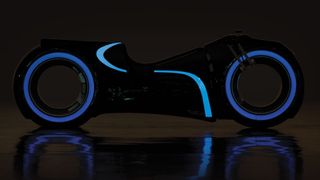
Few bits of movie gadgetry are as iconic as the lightcycles from the TRON movies, and limited edition replicas have been built - the last one sold for $77,000 (around £54,000). [ Sotheby's ]
18. Ghostbusters Proton Pack
Again an authentic, full-sized replica rather than an actual ghost-capturing laser gun, but this proton pack will have everyone fooled and will make you feel just like Bill Murray. [£500 ($715), Etsy ]
19. Jibo Social Robot
Robot companions have a long and illustrious history throughout the age of cinema, and Jibo is one of the newest (and smartest) bits of kit you can get (soon) for your home. [Pricing TBC, Jibo ]
20. Spy glasses
Seen in many a film but perhaps most famously in Mission: Impossible, spy glasses let you record what you're watching discreetly. As Google Glass is no longer on sale try this cheaper Neelam pair. [£64.99 ($95), Amazon ]
Dave has over 20 years' experience in the tech journalism industry, covering hardware and software across mobile, computing, smart home, home entertainment, wearables, gaming and the web – you can find his writing online, in print, and even in the occasional scientific paper, across major tech titles like T3, TechRadar, Gizmodo and Wired. Outside of work, he enjoys long walks in the countryside, skiing down mountains, watching football matches (as long as his team is winning) and keeping up with the latest movies.

Which streaming device will make your TV viewing smarter?
By Rik Henderson Published 10 May 24

Knee pain when you squat? No problem! Maximise your gains with these moves instead
By Bryony Firth-Bernard Published 10 May 24
Useful links
- When is the next Prime Day?
- Best 5G phones
- Best VPN services
- Best laptops
- Best smartphones
- Best mattresses
- Best phone deals
- Best mattress deals
- Best TV deals
- Discount codes
You are using an outdated browser. Please upgrade your browser to improve your experience and security.

- PERSPECTIVES
- Military & Aerospace
- AI & Big Data
- Power Management
- Industrial Control & Automation
- Programmable Logic
- Prototyping
- Test & Measurement
- Wireless & Networking
- Silicon Grapevine
- Education Link
- EETimes University
- Tech Papers
- Special Projects
Star Trek “gadgets” that now exist
I just received an email from David Ashton â the hero in Australia who fixed my DIY Geiger counter and made it count ( Click Here to read that tortuous tale).
David asked if I had heard of the This Is True newsletter ( www.thisistrue.com ) which â he tells me â combines some thought provoking articles with a âGood Laughâ . He also says that thereâs a free version (I like free) and a paid one that has twice the number of stories. I just bounced over there and signed up for the free subscription to âdip my toes in the waterâ as it were.
This does look interesting. On their front page they say that they focus on strange-but-true stories like the following:
- A man who sued his doctor because he survived his cancer longer than the doctor predicted.
- Two robbers who were in the process of their crime when one changed his mind and arrested the other.
- A woman who had her husband's ashes made into an egg timer when he died so he could still “help” in the kitchen.
- The fact that only 68 of 200 Anglican priests polled could name all Ten Commandments, but half said they believed in space aliens.
Hmmm, maybe Iâm a closet Anglican priest (Iâll have to ask my mom) because this pretty much describes me. Actually, that reminds me of a jokeâ¦.

One night a cat is prowling around outside the house in which it lives when it hears a rustling in the bushes. The cat pounces and grabs something in the dark and a fight ensues. Eventually the cat wins and drags its catch out into the moonlight, where he discovers heâs captured a little man-shaped creature dressed in brightly colored clothes. âWhat sort of creature are you?â asks the cat. âIâm a gnome,â replies the creature. âA gnome?â says the cat. âWhat does a gnome do?â âWell,â says the gnome, “I sneak into the house at night and pee in the corners and do other unmentionable things; I play with precious objects and break them; I eat things I shouldnât; and I sing raucous songs loudly and out of tune in the middle of the night and wake everyone up.â The gnome continues by asking âAnd what sort of creature are you?â The cat ponders for a moment and then says âWell, based on your description of what you do, I think I must be a gnome too!â
Hey, I didnât say it was going to be a good joke (grin).
But we digress⦠One of the stories David found on the This Is True site was a link to an article about some gadgets from Star Trek that have come into existence ( Click Here to see this article).
Some of these really do make you think; for example, the âflip-open communicatorsâ that were later emulated by clam-shell cell phones. Or what about the communications earpiece sported by Lieutenant Nyota Uhura, which is eerily like a modern Bluetooth earpiece (I still find it strange when someone walking past me in the supermarket suddenly commences a conversation with an âinvisible friendâ ).
Or how about the fact that, in Star Trek: The Next Generation , crew members used flat, touch-based panels that are uncannily reminiscent of todayâs iPads. In fact, I just discovered that there is an Official Star Trek PADD (Personal Access Display Device) app for the iPad that âImmerses fans in a rich interactive database of Star Trek information and images with an authentic reproduction of the LCARS style interface introduced in the Star Trek: The Next Generation seriesâ ( Click Here to see more details)

Reading this article reminded me that there used to be a company called Time Domain based in Huntsville, Alabama (where I currently âhang my hatâ and call home â I moved here for the nightlife [grin]). Unfortunately they went out of business some time ago, but they were working on a handheld device (reminiscent of a Star Trek Tricorder) that used some interesting technology to âsee through wallsâ. That is, you could detect whether or not a human was on the other side of a wall and his/her location, which would be very useful for firefighters and soldiers and suchlike.
Truth to tell, I hadnât given this much thought before, but now itâs been brought to my attention, the next time I watch some of the earlier Star Trek episodes I shall try to pay attention to the artifacts that seemed so âfar-futureâ then and yet seem so âho humâ nowâ¦
If you found this article to be of interest, visit Programmable Logic Designline where â in addition to my blogs on all sorts of “stuff” (also check out my Max’s Cool Beans blog) â you will find the latest and greatest design, technology, product, and news articles with regard to programmable logic devices of every flavor and size (FPGAs, CPLDs, CSSPs, PSoCs…).
Also, you can obtain a highlights update delivered directly to your inbox by signing up for my weekly newsletter â just Click Here to request this newsletter using the Manage Newsletters tab (if you aren't already a member you'll be asked to register, but it's free and painless so don't let that stop you [grin]).
Share this:

Max is editor of EE Times Programmable Logic and Microcontroller Designlines, and Editor in Chief of All Programmable Planet (www.AllProgrammablePlanet.com)
Leave a Reply Cancel reply
You must Register or Login to post a comment.
This site uses Akismet to reduce spam. Learn how your comment data is processed .
Advertisement

Voice of the Engineer
Star Trek “gadgets” that now exist

I just received an email from David Ashton – the hero in Australia who fixed my DIY Geiger counter and made it count ( Click Here to read that tortuous tale).
David asked if I had heard of the This Is True newsletter ( www.thisistrue.com ) which – he tells me – combines some thought provoking articles with a “Good Laugh” . He also says that there’s a free version (I like free) and a paid one that has twice the number of stories. I just bounced over there and signed up for the free subscription to “dip my toes in the water” as it were.
This does look interesting. On their front page they say that they focus on strange-but-true stories like the following:
- A man who sued his doctor because he survived his cancer longer than the doctor predicted.
- Two robbers who were in the process of their crime when one changed his mind and arrested the other.
- A woman who had her husband's ashes made into an egg timer when he died so he could still “help” in the kitchen.
- The fact that only 68 of 200 Anglican priests polled could name all Ten Commandments, but half said they believed in space aliens.
Hmmm, maybe I’m a closet Anglican priest (I’ll have to ask my mom) because this pretty much describes me. Actually, that reminds me of a joke….
One night a cat is prowling around outside the house in which it lives when it hears a rustling in the bushes. The cat pounces and grabs something in the dark and a fight ensues. Eventually the cat wins and drags its catch out into the moonlight, where he discovers he’s captured a little man-shaped creature dressed in brightly colored clothes. “What sort of creature are you?” asks the cat. “I’m a gnome,” replies the creature. “A gnome?” says the cat. “What does a gnome do?” “Well,” says the gnome, “I sneak into the house at night and pee in the corners and do other unmentionable things; I play with precious objects and break them; I eat things I shouldn’t; and I sing raucous songs loudly and out of tune in the middle of the night and wake everyone up.” The gnome continues by asking “And what sort of creature are you?” The cat ponders for a moment and then says “Well, based on your description of what you do, I think I must be a gnome too!”
Hey, I didn’t say it was going to be a good joke (grin).
But we digress… One of the stories David found on the This Is True site was a link to an article about some gadgets from Star Trek that have come into existence ( Click Here to see this article).
Some of these really do make you think; for example, the “flip-open communicators” that were later emulated by clam-shell cell phones. Or what about the communications earpiece sported by Lieutenant Nyota Uhura, which is eerily like a modern Bluetooth earpiece (I still find it strange when someone walking past me in the supermarket suddenly commences a conversation with an “invisible friend” ).
Or how about the fact that, in Star Trek: The Next Generation , crew members used flat, touch-based panels that are uncannily reminiscent of today’s iPads. In fact, I just discovered that there is an Official Star Trek PADD (Personal Access Display Device) app for the iPad that “Immerses fans in a rich interactive database of Star Trek information and images with an authentic reproduction of the LCARS style interface introduced in the Star Trek: The Next Generation series” ( Click Here to see more details)

Reading this article reminded me that there used to be a company called Time Domain based in Huntsville, Alabama (where I currently “hang my hat” and call home – I moved here for the nightlife [grin]). Unfortunately they went out of business some time ago, but they were working on a handheld device (reminiscent of a Star Trek Tricorder) that used some interesting technology to “see through walls”. That is, you could detect whether or not a human was on the other side of a wall and his/her location, which would be very useful for firefighters and soldiers and suchlike.
Truth to tell, I hadn’t given this much thought before, but now it’s been brought to my attention, the next time I watch some of the earlier Star Trek episodes I shall try to pay attention to the artifacts that seemed so “far-future” then and yet seem so “ho hum” now…
If you found this article to be of interest, visit Programmable Logic Designline where – in addition to my blogs on all sorts of “stuff” (also check out my Max’s Cool Beans blog) – you will find the latest and greatest design, technology, product, and news articles with regard to programmable logic devices of every flavor and size (FPGAs, CPLDs, CSSPs, PSoCs…).
Also, you can obtain a highlights update delivered directly to your inbox by signing up for my weekly newsletter – just Click Here to request this newsletter using the Manage Newsletters tab (if you aren't already a member you'll be asked to register, but it's free and painless so don't let that stop you [grin]).
div-gpt-ad-inread
0 comments on “ Star Trek “gadgets” that now exist ”
Leave a reply cancel reply.
You must Sign in or Register to post a comment.
[ninja_form id=2]
- The Inventory
10 Futuristic Technologies That Will Never Exist
Part of the joy of science fiction is seeing all the awesome toys, and imagining how they could exist in the real world. And so many of science fiction's coolest gadgets have come true, including Star Trek's PADDs and communicators.
Related Content
But the sad truth is, a lot of the most fantastic technologies in science fiction are fantastic for a reason — they can't ever exist in reality. Here are 10 amazing technologies that will never exist in real life.
1. Lightsabers
Aside from the sheer impracticality of this weapon — and not to mention how hazardous it would be to wave one of these around — the Star Wars lightsaber will almost certainly never come to be. The first engineering challenge would be in figuring out a way to stop the beam of light about two feet from the source. Light simply does not work in this way, unless there's something to obstruct or absorb it. Similarly, a highly concentrated beam of light wouldn't be able to cut through materials, or face resistance when striking another lightsaber. Assuming, therefore, that it's not actually a "light" saber, but rather some kind of plasma-beam saber (one that's available in a delicious assortment of colors), the intense heat would likely melt the handle — and possibly burn the Padawan to a crisp. There's also the power source to consider; these suckers pack quite a punch, deflecting laser beams and cutting through solid metal walls, so they would likely require something substantially more powerful than a pair of double-A's. A power source that powerful doesn't, and can't, exist.
2. Human Teleportation
A staple of the Star Trek universe is the capacity to beam, or teleport, humans from one location to another. As legend has it, Gene Roddenberry came up with the idea as a work-around to filming expensive scenes involving ships taking off and landing. But his idea slashed both the budget and common sense. Yes, quantum teleportation has been demonstrated in the lab — but spawning a pair of entangled photons across vast distances is a far cry from teleporting an entire human body. Moreover, Star Trek 's teleportation scheme involves what's called "destructive copying," meaning that the source person must be obliterated (as evidenced in the TNG episode "Second Chances" when you accidentally get two Rikers). So, even if teleportation is somehow possible, it doesn't solve the problem that you'd be stepping into a suicide machine. And finally, the physical and energy requirements of teleportation simply won't allow for it. The system would have to be capable of the instantaneous scanning, recording and relaying of all 10 45 bits of information that make up the human body, then transmit all this data to the destination, and finally compile the person without so much as putting a single molecule out of place. You go first.
3. Time machine
Thanks to Albert Einstein we know that time travel is possible. If you think about it, we're all time travellers, inexorably moving forward into the future without even having to think about it. But more conceptually, Einstein's theories have suggested that "wormholes" can connect two disparate regions of space and time, potentially allowing for the creation of time machines. Okay, great — so knowing that, now what do we do? Well, according to physicist Michio Kaku , we would need to extract the energy of an entire star or black hole — easier said than done. And then there's the challenge of stabilizing the wormhole and ensuring that the aperture (or wormhole entry point) remains open for the return journey (one way trip into the past, anyone?). But even if physics is on our side, metaphysics is not. The "grandfather paradox" suggests that any technology that lets you kill your own ancestor can't possibly exist, because it would break the cosmos. But there's an even tougher paradox to consider: If time travel is possible, then where are all the time travelers from the future?
4. Faster than light travel
Unlike time travel, which at least has some (reasonably) viable science behind it, the suggestion that we'll eventually be able to travel faster than the speed of light (FTL) is a clear and present violation of Einsteinian physics. The universe has a built-in maximum clock speed against which all linear processes are measured, including the propagation of matter and information. There has been some speculation that Einsteinian relativity allows for FTL particles to exist, what are called tachyons — but recent insights have largely put this idea to rest. First, there is simply no evidence for their existence. And second, they couldn't possibly exist because their presence would allow for FTL information transfer — a clear violation of causality. And more to the point, even if they are eventually discovered, it's highly doubtful that we could take advantage of the tachyon phenomenon to create a warp or Alcubierre drive . The intense energy requirements alone violate plausibility — an estimated energy equivalent of -10 64 kg would be required for the effect — which is more than the mass of the entire Universe itself! Lastly, it would be impossible for the ship to send signals to the front of the FTL bubble , meaning that the crew members could not control, steer, or stop the ship — kind of a problem. And assuming the ship could somehow be stopped, its massive expenditure of gamma rays and high energy particles would completely annihilate anyone waiting at the destination .
5. Generation ships
With all due respect to fans of Robert Heinlein and Larry Niven, no interstellar ark awaits you in the future. The idea behind generation ships is that, given the extreme distances between solar systems, and considering the needs of biological humans, we'll need to build a kind of Earth in microcosm to make our intrepid spacefarers feel at home as they make their journey. A fundamental problem with this vision, however, is the tremendous scale involved for what should be a rather lean-and-mean expedition. Any ship carrying colonists to another planet would have to be extremely sensitive to resource and material constraints, thus making suspended animation a much more reasonable solution for a large group of colonists. Not only the that, the dubious ethics of raising a family on a starship, along with the tremendously vast timescales involved, would likely prevent anything like this from actually coming about.
6. Gravitational shielding
Gravitational shielding (or anti-gravity) — which is not to be confused with free fall orbit, or balancing the force of gravity with another force like electromagnetism or aerodynamic lift — is the idea of creating a place or an object that is free from the forces of gravity. First proposed by H. G. Wells in his classic novel The First Men to the Moon as a way to advance spaceflight, this goal has turned out to be unreachable, according to generations of scientists. As appealing as it would be to figure out a way to somehow negate a fundamental property of matter, this prospect will have to remain within the realm of science fiction. Again, it's a simple violation of Einsteinian physics. But this hasn't stopped experimental physicists and engineers from trying, leading to such speculative non-starters as Thomas Townsend Brown's 1920s era "gravitator" or Eugene Podkletnov's gravitoelectric coupling technique (1996) in which he claimed that an object weighed less over a spinning superconductor — both of which were complete vaporware and never proven.
7. Personal force fields
While it is certainly conceivable that a spacecraft could eventually surround itself with a protective layer of charged plasma or a powerful electromagnetic force, the idea of a personal force field poses a different problem altogether. The very essence of the force field is to either absorb or reflect massive amounts of incoming energy. Consequently, it would have to exert an equal or greater amount of force outwards to prevent the energy from passing through the shield (yes, I know — physics is ruining everything). The only cosmological force suitable for a personal force shield would be electromagnetism, because the other forces, namely gravity and the strong and weak forces, are either way too weak or are constrained across short distances. The problem with electromagnetic force, however, is that it only works on charged objects — and humans are electrically neutral. Moreover, even if we could somehow develop a device that envelopes a person with a powerful shield, there's no guarantee that the person inside it wouldn't be fried by the thing; it would be impossible to make the force field omni-directional.
8. Reanimation from cryonic suspension
A fundamental problem with the state of cryonics today is not the idea behind it, but the method of preservation. We've believed since the publication of K. Eric Drexler's Engines of Creation that reanimating a perfectly preserved brain will someday be possible, using molecular nanotechnology. A critical assumption behind this theory, however, is that the brain needs to be perfectly preserved, to avoid what's called "information theoretic brain death." Simply put, if there's too much damage to the cells in your preserved brain, there will be no way to bring you back. And unfortunately, virtually every cryonic preservation that has been done to date has experienced problems. Despite the use of sophisticated cryoprotectants , every preserved brain has undergone severe fracturing during the freezing process. It's also very likely that the cells will turn to mush during thawing (unless the cryopreservants do their job — which has obviously never been tested). Now this is not to suggest that reanimation from some other preservation scheme won't eventually be possible, such as brain plastination or chemical preservation . Turning bodies into popsicles just probably isn't the best way to do it — but as cryonicists like to say, it's still the second worst thing that can happen to you.
9. Continuity of consciousness after uploading
While the prospect of uploading our minds into supercomputers remains a distinct possibility, it's an open question as to whether or not we'll also be capable of transferring our consciousness as well. Most uploading schemes describe the copying of neural information from biological to digital substrate — but what's often lost in the conversation is the question of how a person can suddenly be in two places at once. Destructive copying (similar to the teleportation problem), will still result in a perfectly replicated person who will adamantly insist that they're the genuine thing — but so would the other 50 copies. As for the original source consciousness, it would cease to exist. This is what's referred to as the "continuity of consciousness problem," and it's a matter of great contention in the philosophical, neuroscientific, and AI communities. Part of the problem is that we still don't have a developed science to explain the nature of consciousness, so we're left guessing. As futurist John Smart told io9, it's likely an issue that will never be satisfactorily resolved. "This is an issue that will eventually start to take on religious or spiritual connotations," he said, "people will just have to take a leap of faith and make the jump."
10. Infinite data processing
No matter how sophisticated our future technologies get, we're inevitably going to have to face the fact that the death of the Universe will subsequently result in our demise as well. Even people living as uploads are going to have to eventually face their own oblivion — true cosmological immortality will not be possible. There will be no Tiplerian Omega Point , nor will we ever develop a form of computation that will allow us to crunch on for an infinity. But that doesn't mean we won't go down without a fight. Our descendants will likely embark on a series of cosmological engineering projects to stave off the inevitable, such as stellar husbandry (to increase the lifespans of stars) or somehow tap into the power of black holes. There's even the possibility of dramatically increasing our computational clock speeds to subjectively extend the remaining time we have left. But none of these schemes will be able to counter the heat death of the universe or the Big Rip — nothing can escape the power of entropy or the ravaging effects of rapidly accelerating dark energy.
Images: technologijos.lt , ultraforcesabers , KOBOL/Telegraph , immortalmuse , pcmag.com , the-leaping-lamp , Wikipedia/Magafuzula , tombsofkobol , Screened , FutureTimeline , discovery-enterprise .

Will Artemis astronauts look for life on the moon?
Some hardy microbes might be able to survive on Earth's nearest neighbor — likely after making the trek there with us.

If NASA planning remains on the rails politically, technically and financially, the United States will plant new footprints on the moon toward the end of 2025.
That touchdown, on a mission called Artemis 3 , will be the first human lunar landing since Apollo 17 moonwalkers stirred up the gray dust in December 1972.
Artemis 3 is intended to be the first of a number of human missions to the Artemis Polar Exploration Zone — the region poleward of 84 degrees south latitude.
Selecting a safe and science-worthy landing region for Artemis 3 is a challenging task. But there's no doubt that great discoveries lie ahead — and one potential surprise could be detecting life on the moon .
Related: NASA's Artemis 3 mission: Landing humans on the moon

Super-cold craters
New research suggests that future visitors to the lunar south pole region should be on the lookout for evidence of life in super-cold permanently shadowed craters — organisms that could have made the trek from Earth .
Microbial life could potentially survive in the harsh conditions near the lunar south pole, suggested Prabal Saxena, a planetary researcher at NASA's Goddard Space Flight Center in Greenbelt, Maryland.
Get the Space.com Newsletter
Breaking space news, the latest updates on rocket launches, skywatching events and more!
"One of the most striking things our team has found is that, given recent research on the ranges in which certain microbial life can survive, there may be potentially habitable niches for such life in relatively protected areas on some airless bodies," Saxena told Space.com.
Indeed, the lunar south pole may possess the properties that can enable survival and potentially even episodic growth of certain microbial life, Saxena said.
"We're currently working on understanding which specific organisms may be most suited for surviving in such regions and what areas of the lunar polar regions, including places of interest relevant to exploration, may be most amenable to supporting life," he said.
In work presented at a recent science workshop on the potential Artemis 3 landing sites, Saxena and study members reported that the lunar south pole may contain substantial surface niches that could be potentially habitable for a number of microorganisms.
Related: See Artemis 3 landing zone near moon's south pole in stunning new NASA photos
Earth's history — on ice
Is it possible that samples of Earth's history could be lurking in sun-shy lunar craters?
Small pieces of our planet might have been hurled to the moon as "Earth meteorites" — rocks blasted into space by powerful cosmic impacts.
That is indeed a possibility, said Heather Graham, an organic geochemist at NASA Goddard who's also a member of the study team. But that doesn't mean that Earth microbes also survived that deep-space trip.
"While extraterrestrial transfer of organic molecules from meteoritic sources is very likely, and indeed observed in our own terrestrial meteorite analysis, the transfer of microbes from similar sources does not have the same weight of evidence," Graham said. "It may be an interesting idea, but without viable data this route cannot be included in this study."
Graham said that, more importantly, the study team is very aware of the many ways that humans are the biggest vector of microbes to the moon.
"We will soon have 50 years of history of humans and their objects on the surface with no stringent requirements regarding forward contamination," she said.
"We view humans as the most likely vector given the extensive data that we have about our history of exploration and the impact record as a second, albeit less influential, early terrestrial source," Graham added.
Protected micro-niches
Graham pointed out that the way the study team is approaching this problem isn't necessarily because they think Artemis missions will cause a flood of microbes to bloom immediately near the lunar south pole in a "dorm room fridge" scenario.
"Rather…we will almost certainly deposit hearty spores in protected micro-niches where the max temperature and radiation protection features at that site will allow them to persist," Graham said. "This is the 'survival' end of the scale with spores present."
Over time, Graham said, ongoing exploration of the moon could continue to deliver water and carbon sources to these locations, which could one day result in growth.
Artemis flight path
— NASA's Artemis program: Everything you need to know
— What would it be like to live on the moon ?
— NASA's Artemis 3 mission: Landing humans on the moon
Also foreseeing a possible impact from increased traffic to the moon is Paul Lucey of the Hawaii Institute of Geophysics and Planetology at the University of Hawaii at Mānoa.
"There is no question the final approaches of the Artemis spacecraft will deposit carbon dioxide and water ice in permanently shadowed regions along the flight path and may compromise some kinds of investigations," Lucey told Space.com.
On the other hand, Lucey said that our understanding of how lunar ice is deposited is meager right now, "so these will be very interesting experiments to conduct, given the right instrumentation."
It is likely there will be no comprehensive survey of the abundance of those compounds before the first Artemis surface missions, Lucey observed, so unfortunately the natural background will not be known for the lunar south pole. (One Artemis mission has launched to date — Artemis 1 , which went to lunar orbit last fall.)
The moon's north pole will be better preserved, Lucey said, but spacecraft exhaust may also affect the north via transport through the lunar "exosphere" — its very thin and tenuous envelope of gases.
Saxena concluded that considerations for how to investigate a lunar site, if it is near to regions that may be potentially habitable niches, should be taken into account for future site assessment and traverse planning.
"These means of planning and corresponding strategy, techniques and instrumentation that may be involved might be valuable for exploration of Mars as well," he said.
Join our Space Forums to keep talking space on the latest missions, night sky and more! And if you have a news tip, correction or comment, let us know at: [email protected].

Leonard David is an award-winning space journalist who has been reporting on space activities for more than 50 years. Currently writing as Space.com's Space Insider Columnist among his other projects, Leonard has authored numerous books on space exploration, Mars missions and more, with his latest being "Moon Rush: The New Space Race" published in 2019 by National Geographic. He also wrote "Mars: Our Future on the Red Planet" released in 2016 by National Geographic. Leonard has served as a correspondent for SpaceNews, Scientific American and Aerospace America for the AIAA. He has received many awards, including the first Ordway Award for Sustained Excellence in Spaceflight History in 2015 at the AAS Wernher von Braun Memorial Symposium. You can find out Leonard's latest project at his website and on Twitter.
Science and music festival Starmus VII is about to rock Bratislava with a stellar lineup
China's Chang'e 6 mission to collect samples of the far side of the moon enters lunar orbit (video)
'Extreme' solar storms cook up sweet Mother's Day auroras for Moms everywhere
Most Popular
- 2 The stormy sun erupts with its biggest solar flare yet from a massive sunspot — and it's still crackling (video)
- 3 Houston, we have an encore: ISS virtual reality experience 'The Infinite' returns
- 4 Total solar eclipse 2027: A complete guide to the 'eclipse of the century'
- 5 This Week In Space podcast: Episode 110 — Voyager 1's Brush with Silence
Screen Rant
Star trek finally admits a classic gadget makes no sense.

Your changes have been saved
Email Is sent
Please verify your email address.
You’ve reached your account maximum for followed topics.
Star Trek Actors & Executive Producers React To Peabody Award
5 star trek actors with real-life children in tv & movies, star trek returns to a ds9 & voyager location for the first time in 25 years.
Star Trek has finally admitted that the name of one of its signature devices makes no sense. Star Trek is renowned for its adherence to real-world scientific principles, but every so often the franchise must create new devices and technology that do not exist in our world (yet). These devices sometimes carry with them unique and clever names, but in IDW Publishing’s Star Trek: Lower Decks #2 , one of them gets a humorous call-out.
The issue is written by Ryan North and Chris Fenoglio. Throughout the Lower Decks comic, the creators put humorous, fourth-wall breaking jokes at the bottom of the page. These little gags range from commentary on the action to truly random, borderline scatological blurbs. One such blurb concerns Ensign Rutherford’s favorite gadget–which he says are dermal regenerators. The blurb explains that Rutherford has been put on the spot–hence the weird answer. It goes on to list some of the other devices he could have said, such as “ antimatter injectors ” before suggesting, “ Plain old tricorder. They cord in three different ways .”
What Does "Tricorder" Mean, Anyway?
Along with the transporter , the tricorder is one of Star Trek’s signature devices. The tricorder is a small, hand-held device used by Starfleet personnel to scan and analyze objects. There are a variety of tricorders–including a medical model. How the tricorder works has never been explored on Star Trek . It got its name because it can perform three functions: environmental scans, data analysis and data recording. Fans have speculated on how the tricorder works, but an official reason has never been forthcoming, and while Lower Decks does not offer an answer, it does poke fun at the device’s name.
The Tricorder is an Important Piece of Tech
Without the tricorder, Starfleet personnel would not be able to do their jobs, as a good portion of it involves scanning, recording and analyzing data. Yet the tricorders’s inner workings, like much of Star Trek’s technology, remains a mystery. The transporter is similar in this regard : the device breaks a subject down at the subatomic level and reconstructs them at their destination. In the real world, such a device would be impossible because of the Heisenberg Uncertainty Principle; yet the transporters have a wonderful invention called “the Heisenberg Compensators,” which provides a workaround. Some of Star Trek’s technology, such as warp drive, is rooted in real-world science but the tricorder remains a mystery.
Calling out the somewhat goofy name of the tricorder is part of what gives Star Trek: Lower Decks its appeal. The show calls out numerous Trek tropes, and now it is the tricorder's turn, as well as the franchise's tech as a whole. The gag acknowledges that while Star Trek attempts to remain grounded in the real world, it must occasionally reach out into the realm of pseudo-science, creating fantastic devices that defy explanation.

IMAGES
VIDEO
COMMENTS
4. Tractor Beams. Star Trek 's tractor beam, a concept that has appeared in science fiction since the 1930s, rests on the idea of a high powered energy beam locking on and attracting a foreign object, spaceship, or person. The idea, originally called an 'attractor beam', has appeared in a wide range of science fiction stories in the years ...
Here are 12 gizmos used on the Star Trek television shows that are now becoming real. 1. Food Replicator. Captain Jean-Luc Picard used to say "Tea, Earl Grey, hot!" and it would be replicated ...
Be it the iPad, Surface Pro, Samsung Galaxy Tab, etc., the ability to use touchscreen technology with a handheld portable device makes online communication much faster, leading to greater global connectivity. In Star Trek, the Personal Access Display Device (aka PADD) was a 22nd-century gadget used by Starfleet and other space-traveling units.
The air pressure shoots the liquid vaccine deep enough into the skin that no needle is required. The real-world application is known as a jet injector. Jet injectors have been in use for many years. In fact, the technology predates "Star Trek." Jet injectors were originally designed to be used in mass vaccinations.
Hypospray. Tablet computer. Food replicator. Warp drive. Show 3 more items. While much of it remains science fiction, a sizable number of the gadgets and tech toys that have appeared in Star Trek ...
6. Hypospray. Hypospray is one of the gadgets that is commonly used in Star Trek because Leonard "Bones" McCoy is a doctor, not a time-waster, and this medical device speeds up the process of administering medicine by injecting it through the skin using a non-invasive transport mechanism.
Legendary Star Trek doctor Leonard McCoy uses a tricorder to diagnose medical conditions in a snap. Now, a real-world handheld DNA tester called MinION can recognize the Ebola virus and genetically profile tumors, among other uses. The size of a smartphone, MinION is made by UK-based Oxford Nanopore Technologies.The device just needs a tissue sample, from which to tap DNA, and a laptop, but it ...
The world seen in Star Trek movies and films is meant to take place hundreds of years in the future. But some of the technology portrayed in the shows as wildly futuristic is available now.
Hyposprays. This technology actually predates Star Trek. In the real world, we call hyposprays - a form of hypodermic injection of medication used to deliver inoculations and other medicines - jet injectors. Originally designed for mass vaccinations, jet injectors are safer and faster than standard needles in administering vaccines.
Published September 8, 2016. On September 8, 1966, NBC aired the first episode of a new TV series about a starship on a five year mission of space exploration. Today, Star Trek turns 50. The first ...
Star Trek U.S.S. Enterprise 1701-D - Enterprise Replica Bluetooth Speaker, Engine Noise Sleep Machine, Night Light, Sound Effects - Memorabilia, Gifts, Gadgets, Collectibles for Star Trek Fans ...
The Star Trek universe is full of high-tech gadgets that defy physics, bend reality, and get you to far away places really, really fast. From holodecks that recreate historical situations, to ...
Besides a unique take on faster-than-light travel and energy weapons, one of the most innovative technologies showcased on the original Star Trek was the concept of a computer-assisted medical bed. Of course, we have had mavhines for decades which display basic vital statistics (ex. heart rate, body temperature), but recently the University of Leicester has invested three years of development ...
There have been so many technological innovations since Star Trek premiered in 1966, that an inventory of Trek devices that HAVE been created is a never-ending task. The minute the new AirPods were announced, memes started appearing all over the web showing Uhura and Spock with their earpieces in, insisting that the technology dates back to the 1960s. . Even our day-to-day tech makes some of ...
This article is more than 8 years old. Since Star Trek first aired in 1966, the show has featured a number of science fictional technologies. And some of those have moved beyond science fiction to ...
When Star Trek first aired in 1966, every gadget on the show was truly futuristic. Even though we haven't perfected teleporting (yet), many of the gadgets that made this show great are now part of our everyday lives in some form. You can also find a lot of the technology we use today in the last Star Trek film, which largely borrowed from real life.
4. Star Trek Virtual Display Device Google Glass. The headsets allowed the evil Dominion to see outside their ships with just a turn of the head, like having a screen in your brain. Google Glass ...
7. Batman Grapnel Gun. Batman has always had some tasty gadgets to his name, like this grapnel gun: squeeze the trigger and you get 11 feet (about 3.4 metres) of rope to play around with in for ...
I just read an article about eight gadgets from Star Trek that have come into existence; some of these really do make you think...
I just received an email from David Ashton - the hero in Australia who fixed my DIY Geiger counter and made it count (Click Here to read that tortuous
The most commonly cited fictional tech gadget Redditors want to see in real life is the Matter Replicator from the long-running sci-fi series Star Trek, a futuristic device that makes perfect duplicates of organic and inorganic material. The device should exist in reality as a way of replicating food, combating the global food shortage, reducing waste, curbing climate change, and bolstering ...
Part of the joy of science fiction is seeing all the awesome toys, and imagining how they could exist in the real world. And so many of science fiction's coolest gadgets have come true, including ...
But there's no doubt that great discoveries lie ahead — and one potential surprise could be detecting life on the moon. Rendering of 13 candidate landing regions for NASA's Artemis 3 mission ...
By Shaun Corley. Published Jun 2, 2023. Star Trek has many signature devices, but now a new issue of the Lower Decks comic series specifically calls out the name of one of them. Star Trek has finally admitted that the name of one of its signature devices makes no sense. Star Trek is renowned for its adherence to real-world scientific principles ...